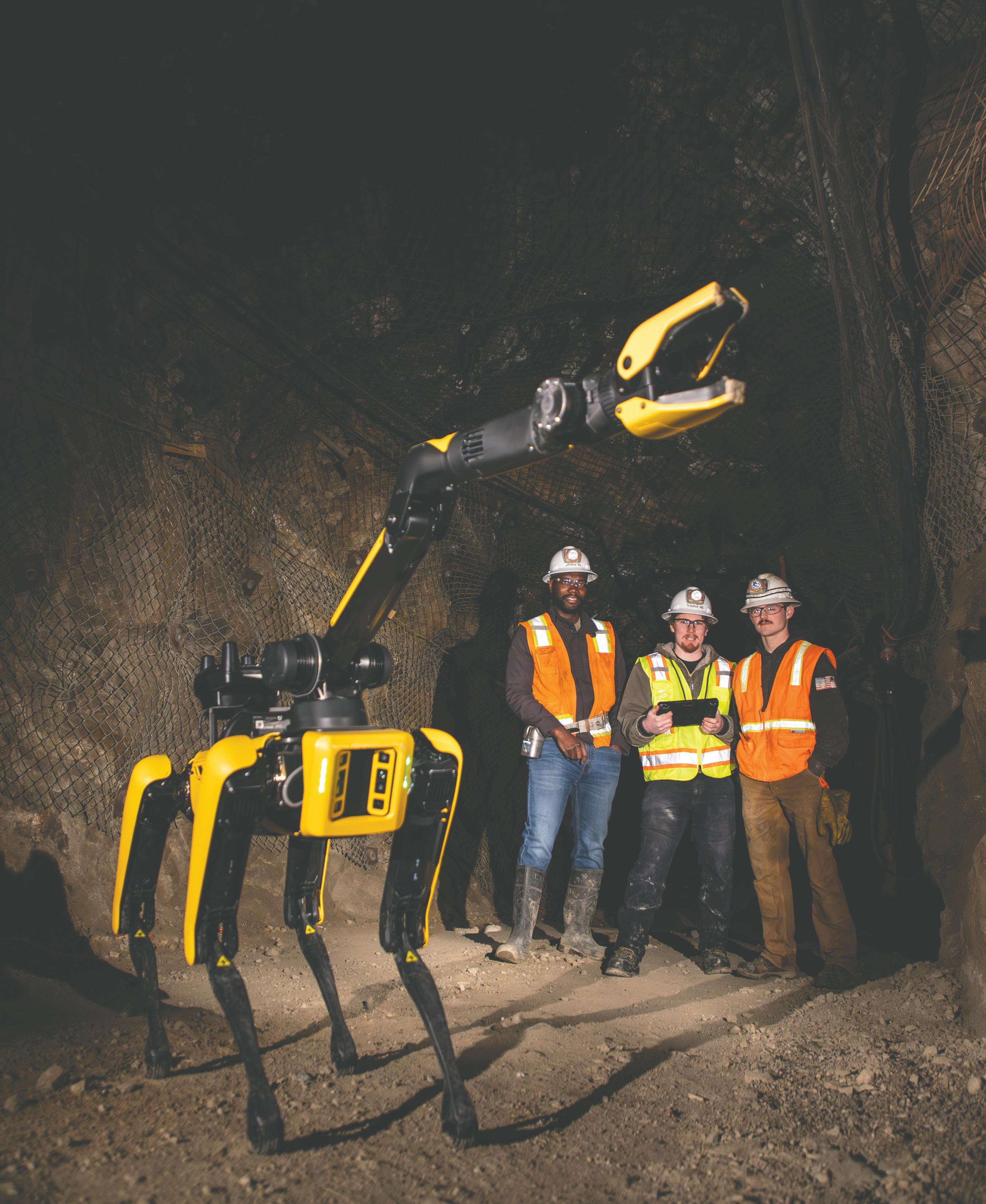





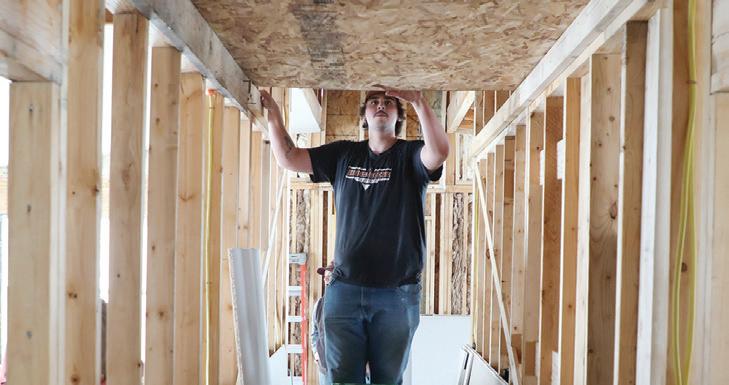
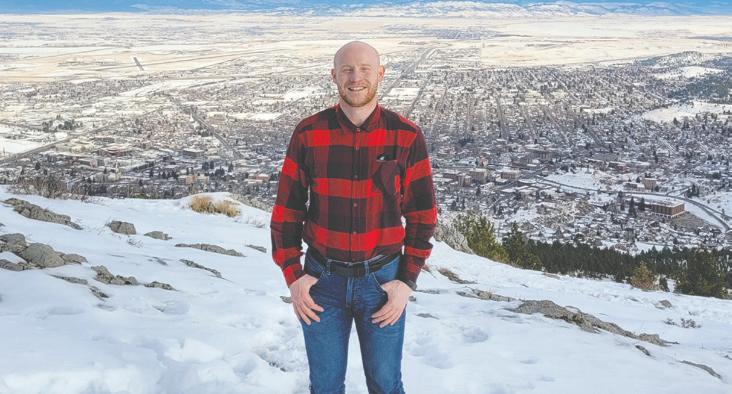
Stick Leg Ranch: A Story of Success
A quarter-century after Seth Becker lost his legs in a drilling accident during a petroleum engineering internship in the Gulf of Mexico, he’s used good humor, perseverance, and ingenuity to build a successful regenerative ranching business with his wife Jennie.
AISES Shoots for the Stars
Every time the Space Race has gained momentum over the past 70 years, Montana Tech Orediggers have answered the call to push the boundaries of their engineering skills to higher altitudes.
Award Winning Winery
Sarah (Morris) Lathrop (B.S. Professional and Technical Communication, ’02) loves owning Liberty Lake Wine Cellars, located in a suburb of Spokane, Washington, but she is quick to rip off the Rosé-colored glasses when she describes her work.
Beauty, Science Emerge in Nanotech Lab
To the untrained eye, the breathtaking images generated in the Montana Tech Nanotechnology Laboratory (MTNL) resemble painted masterpieces possibly inspired by Pablo Picasso’s works in cubism—but to the students who created them, these micrographs hold much more critical data than that of simple abstract beauty.
Teaching a Robot to do the Dirty Work
The U.S. Department of the Interior estimates there could be as many as 500,000 abandoned mine sites on federal land, and researchers at Montana Technological University’s Mining Engineering Department are using novel robotic technology to see if any of those already disturbed sites might hold critical minerals.
Building Dreams
When Andy Larson was in high school, his mom signed him up for a summer internship with a homebuilder in Utah. The teen was hooked, and Larson knew he wanted to make construction a career
The hands-on nature of the program at Highlands College was a big selling point for Larson.
Chasing Gold
In the 100 years prior to the National Student Awards Committee, Montana Tech had one student recognized with the prestigious Goldwater Scholarship. Since the NSAC was formed, 11 Montana Tech students have been honored, and an additional five have received honorable mentions.
16 18 20 24 28 30
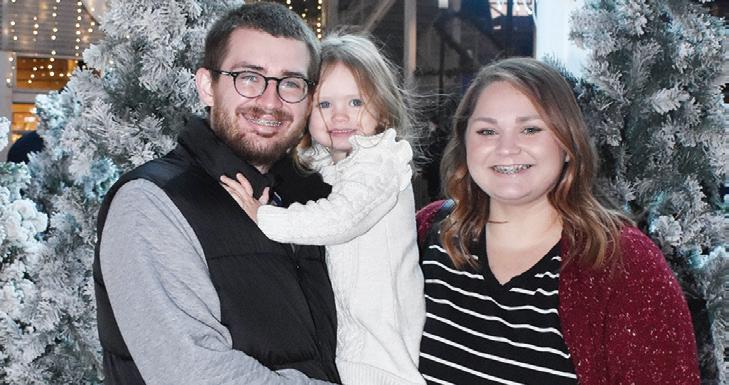
Dream Careers | P. 34
If there ever was a pure embodiment of the term “determined doers,” Kaitlyn and Jeff Preston would be it. Kaitlyn (B.S. Statistics and Mathematical Sciences, ’16) is currently a lead process management analyst at NASA, and Jeff works as a data scientist for Disney.

Taking the Stage | P. 38
The students of Montana Tech know Research Associate Grant Wallace as a professional materials scientist focused on rare earth element recovery—but what many do not know is that Dr. Wallace also has an artistic side.

Liberty Energy Scholarship Transforms Lives | P. 42
Sydney Doyle and Myles McClernan say they only ever had one college in mind as they filled out applications in their senior year at Butte High.

On the Court: Basketball Alum Begins Career as Attorney | P. 36
Kale Guldseth comes from a long line of Oredigger competitors, and dreamt of playing basketball at Montana Tech. He made his dream a reality, and excelled—and currently practices at Drake Law in Helena.
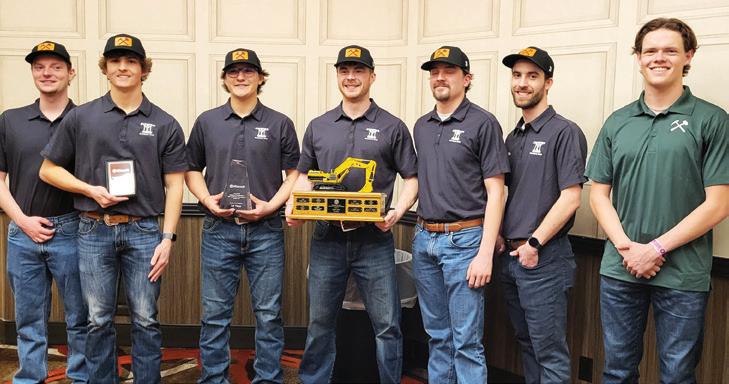
Heavy Civil Team Takes Home Top Honor | P. 40
Montana Technological University teams won top honors at the 46th International Collegiate Mining Competition held in Butte, Montana.

Electric Vehicle Market Offers Opportunities for Students in STEM | P. 44
Sean Everett (BS Environmental Engineering, ’04) graduated from high school in Libby, Montana, just as cleanup began at the site of one of America’s worst human-caused environmental disasters.
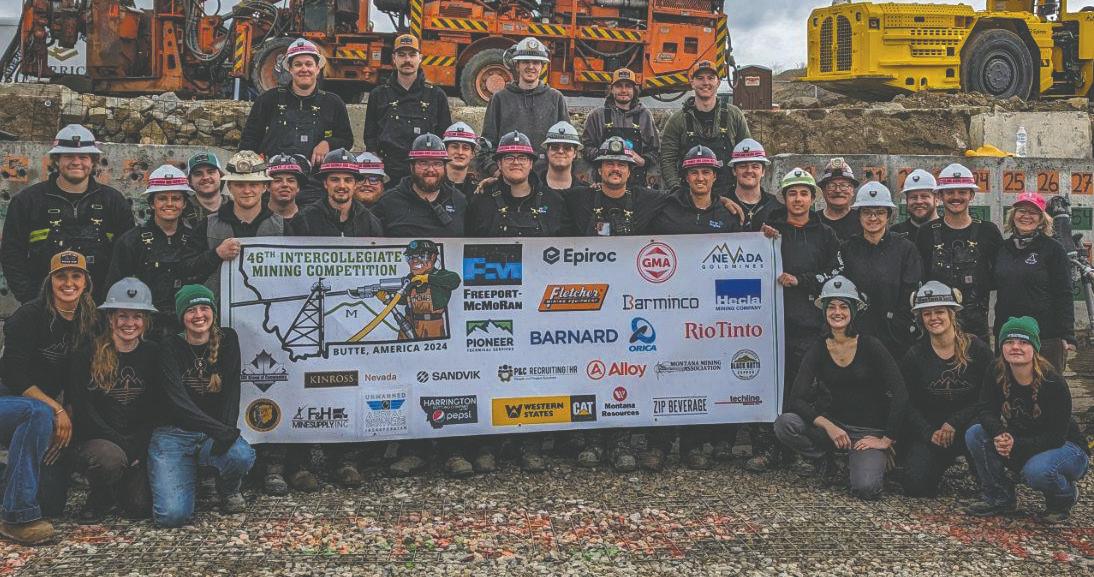
Montana Tech Teams take top honors at 46 TH International Collegiate Mining Competition P. 46
Montana Technological University teams won top honors at the 46th International Collegiate Mining Competition held in Butte, Montana.
Chancellor
P. Cook
Publisher Amanda Badovinac
Writers
Cook
Jodie DeLay
Jaime Heppler
Shannon Panisko
Megan Strickland
Editorial Board
Amanda Badovinac
Stephanie Cook Jodie DeLay
Megan Strickland
Brooke Benson
CONTENTS
FEATURES continued... CREDITS
Les
Les
Susan
Lisa Sullivan Editor
Barth Graphic Designers
Lisa
Lou
ON THE COVER
engineering students, Alan
are
Mine Education
SHORTS Foundation Update | 10 Greetings from the Chancellor | 5 Digging In | 6 12
Sullivan Photographer
Mason MNews is published twice a year by Montana Technological University.
Montana Tech mining
Arthur, Arlo Eades, and Kodis Campbell
pictured in the Underground
Center (UMEC) on campus with SPOT, the robot dog.
FEATURES
MNEWS SPRING 2024 3 2 MNEWS SPRING 2024
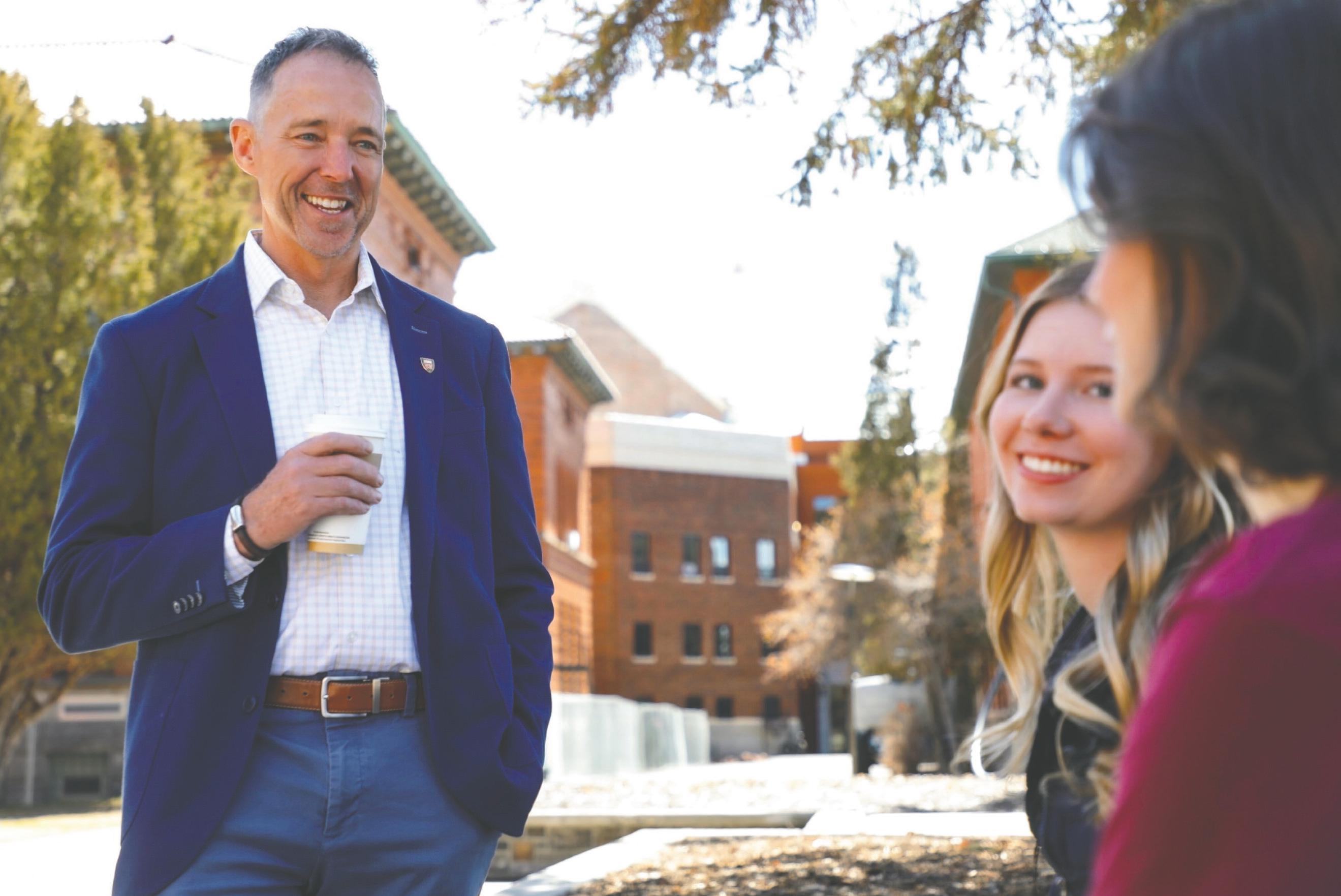

Greetings from the Chancellor
Across the higher education landscape, there are growing concerns about the perceived loss of value in having a college degree, compared to the expense of earning the degree. At Montana Tech, there is no doubt that the investment of time and energy spent in our classrooms, labs, and natural environment translates to impactful jobs and a high-quality life. In this issue, you’ll read stories of how our graduates have used their degrees to create meaningful careers of great value to society, while also thriving personally.
Kaitlyn Preston (B.S. Statistics and Mathematical Sciences, ’16) is a lead process management analyst and data scientist for NASA, working from her home in Orlando, Florida, where she can also care for her young daughter. Her husband, Jeff Preston (Statistics and Mathematical Sciences, ’17), is a data scientist for Disney where he supports the revenue, planning, and optimization of the organization.
Lucas Paugh (B.S. General Engineering, 2005 and Oredigger Football Alum) has turned his passion for big game hunting into an opportunity to give back to Montana Tech. The Venison in the Vines event draws a variety of individuals from oil and gas, agriculture, and industry each spring to Steinbeck Vineyards in Paso Robles, CA. Funds raised have created an endowment providing two $1,000 scholarships annually.
Former Goldwater Scholar Chris Dienes (Mathematical Sciences, 2008) is a data science manager for Amazon, and along with his wife, Erin (Mathematical Sciences, 2007), is the parent of two young kids who are already learning valuable research skills, such as critical thinking, as they spend time together as a family.
Jack Skinner (General Engineering, Mechanical option, 2000) is the director of the Montana Tech Nanotechnology Lab, professor and department head of Mechanical Engineering at Tech. He has shown it’s possible to find work in Montana, and specifically in Butte, and he is making it his mission to help provide more opportunities for work here for his students. His efforts to equip the lab with high-powered electron microscopes and other equipment brings in high-quality, award-winning students prepared to meet the nation’s most pressing future needs.
Research work at Tech is also increasing opportunities for promising careers of the future. Read about Associate Professor Abhishek Choudhury, Ph.D., P.E., SPOT, and the work they are doing to find critical minerals in abandoned mines, which could mean big business for southwest Montana—but definitely means a great, hands-on education for the students involved with the
project. As artificial intelligence rises, it becomes even more important for students to understand and be able to answer the deeper questions about “why” things are how they are. A Montana Tech education gives students a leg up in necessary critical thinking paths.
This hands-on experience also applies to Highlands College degrees. In this issue you’ll learn about the Construction Technology–Carpentry program in which students build an actual home during their course. Montana Tech Prospector Andy Larson was introduced to construction through a summer internship in high school. This spring he is part of a cohort of students who will celebrate the completion of a three-bedroom, two-bath modular home through our construction technology program. It’s not hypothetical, it’s practical, and the end result is tangible and impactful for the community as the home will help address affordable housing needs in Butte–Silver Bow.
You’ll read about an Oredigger basketball star turned attorney, another former Goldwater Scholar turned actuarial analyst, a longtime professional research associate at Tech turned local community theatre actor extraordinaire, and a Professional and Technical Communication grad turned award-winning vintner. You’ll even read about a Petroleum Engineering & Engineering Science grad who, after a tragic accident, started a family and a successful regenerative ranching business with his wife.
And you’ll read about the Liberty Energy Scholarship Program, which helps local Butte students with the costs associated with earning a Montana Tech degree. The first group of Liberty Scholars graduated in May and heard from Liberty Energy Founder and CEO Chris Wright, as he delivered the commencement address.
This issue is clear evidence that those who are willing to work hard while at Montana Tech will leave here with tremendous opportunities to thrive throughout their future. Enjoy these stories. There is a lot to share and even more to be proud of at Montana Tech. We are grateful for your part in our story.
Sincerely,
Les P. Cook Chancellor
MNEWS SPRING 2024 5 4 MNEWS SPRING 2024
DIGGING IN
Venison in the Vines Raises Funds for Oredigger Scholarships
What started several years ago as an informal cookout between friends has grown into a successful annual fundraiser for Montana Tech.
Lucas Paugh (B.S. Occupational Safety and Health, ‘05, M.S. Industrial Hygiene, ‘14) is vice-chair of the Montana Tech Alumni Association’s Bakersfield, California Chapter and co-founder of Venison in the Vines, a private event held at Steinbeck Vineyards and Winery in Paso Robles, California. His co-partner, Ryan Newkirk, is a 6th generation member of the Steinbeck family and oversees all the operations of the vineyard and winery.
“Our goal is connecting the community through locally sourced venison and wine,” Paugh said. “We harvest a couple deer annually on the vineyard, and pair that venison with the wine from the very grounds where both were gathered, along with many wild game appetizers. It’s a fun full circle event and the proceeds go to a great cause.”

“The vision was to create an endowment to offer a yearly scholarship to a local or California student who wants to pursue higher education at Montana Tech,” Paugh said.

Welding Opens Opportunities for Artistic Expression at Highlands College
When people envision a welder, images of workers on pipelines or in manufacturing factories might come to mind. “Most people immediately think of welding as industrial,” Highlands College welding instructor Dennis Noel said. “They don’t think of it as artistic.”
The guest list is limited to around 75 people. “It’s a good mixture of different people in agriculture, the outdoor industry, and in oil and gas,” Paugh said.
The venison is cooked using the flip-flop method, where the whole hindquarter of venison is seared over hot coals, similar to Brazilian-style barbecue. In addition to a world-class dinner, guests can bid on exceptional silent auction offerings that help fund scholarships for future Orediggers.
The endowment has grown to allow the chapter to give away two $1,000 scholarships annually.
“It’s always a great feeling to give back to something that gave you so much,” Paugh said.
Anyone interested in donating to the silent auction or scholarship can reach out to Paugh at lucas@huntinfool.com.
A long line of projects created by Noel’s students showcase the artistic possibilities within the welding field. Noel and his former students created an ironwork fence and two mining headframes with movable pieces that blow in the wind to greet visitors to the Highlands campus. In 2018, students created metal signage for the Ringing Rocks outside Whitehall. This semester, students are creating Smashburger presses that can be customized with Charlie Oredigger and Montana Tech emblems, Damascus steel knives, and metal Tyrannosaurus rex skeletons.
Ryder Taplin is a first-year student in Noel’s class who spent a day putting together a Tyrannosaurus skeleton before helping with a larger one that now hangs overhead in the welding shop.
Taplin said his favorite assignment so far was making the Damascus steel knives. Damascus steel is forged in fire. The welding students heat the metal and work it so it has between 300 and 1,000 layers, creating a beautiful pattern on the blade. He opted to try a folding knife, while all the others made fixed blades. It was a bit more challenging, but worth the work.
“I want to give them assignments to be creative, but also allow them to hone their craftsmanship,” Noel said.
Lucas Paugh, Cindy Steinbeck, and Les Cook at Venison in the Vines
MNEWS SPRING 2024 7 6 MNEWS SPRING 2024
Montana Tech Wins 2024 Safety Olympics
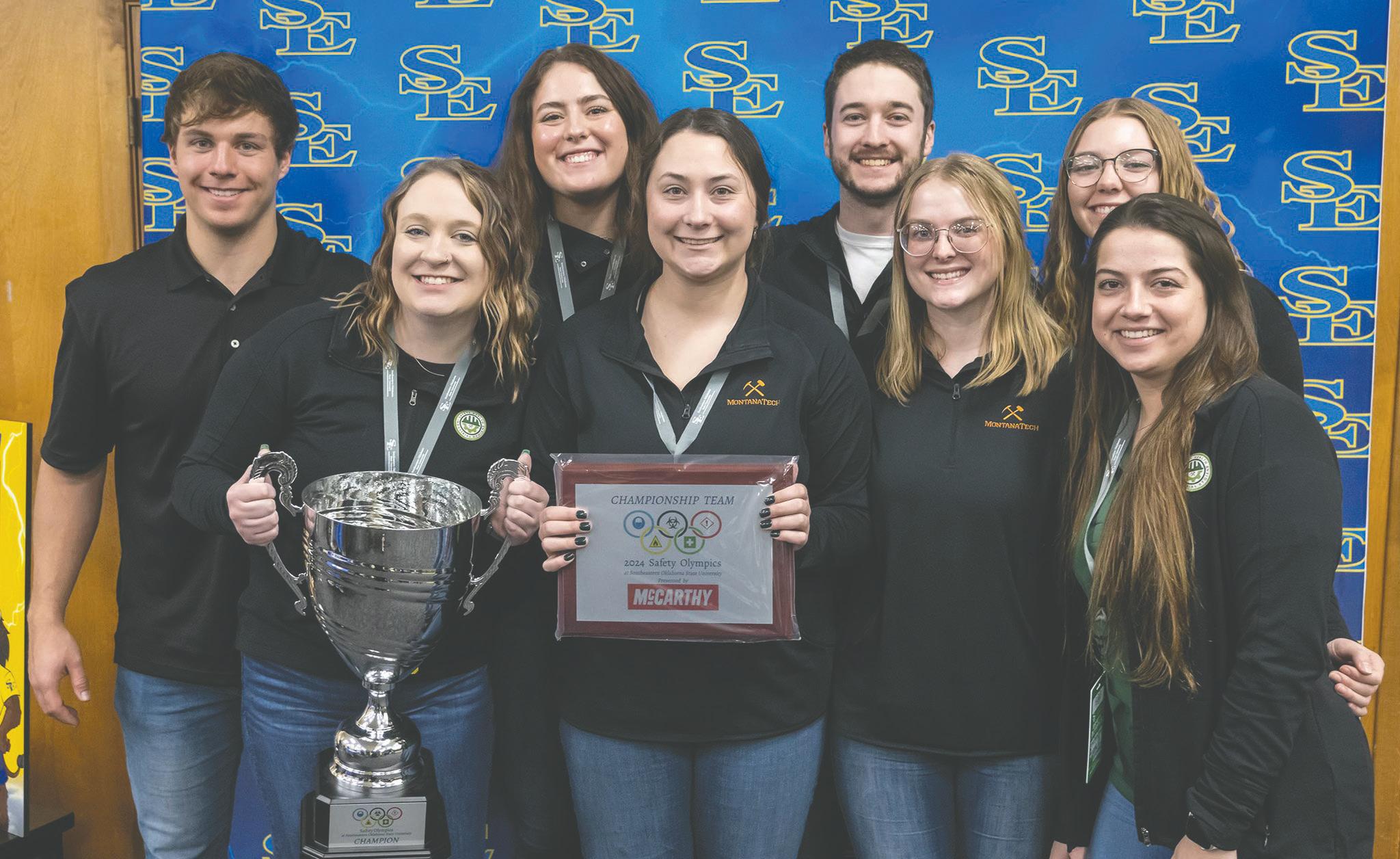
Montana Tech brought home the top prize at the 2024 Safety Olympics held at Southeastern Oklahoma State University in Durant, Oklahoma. This was the University’s first time competing in the annual event, which requires participants to exhibit their skills in occupational health, safety, and industrial hygiene through a series of challenges. This year’s competitors included Collin College, College of the Mainland, Pittsburg State University, Southeastern Oklahoma State University, and the University of Central Missouri.
“We came down from Montana, so it’s our first time participating in the event and we had a blast,” Associate Professor of Safety, Health, and Industrial Hygiene and team coach Lorri Birkenbuel said. “We did not have a clue what the outcome was going to be, but at the end we ended up winning, which was amazing. All of the participants were great, all the competitions were great, and we had a great time.”
He’s a Match
A leukemia patient is about to have a better chance at survival thanks to Oredigger football player Maximus Anderson. The business junior from Kalispell attended an event co-hosted by the Montana Tech football team and the Be the Match Foundation in Spring 2022.
In Fall 2023 Anderson was contacted by Be the Match. He learned a 63-year-old man could use his white blood cells.
“I pumped my fist a bit,” Anderson said. “It was exciting.”
In the first week of March, Anderson took injections to help boost his white cell count for several days, before traveling to Arizona to have his blood circulated through a machine for 4-6 hours to collect the white blood cells. “Do your research before you sign up,” Anderson said. “But I do encourage people to get signed up and figure out if you are a match or not.”
Bob Morris Selected as Lance Energy Chair
Bob Morris has been selected as the recipient of the inaugural endowed Lance Energy Chair. The chair will enhance the prominence of Montana Tech as a national leader in energy by leveraging private funding and developing partnerships with industry, trade organizations, national labs, and state/federal agencies. The position was created as part of a historic $31 million donation to the Montana Tech Foundation from alumnus Ryan Lance (Petroleum Engineering, ’84) and his wife Lisa in April 2023.
Morris is a Butte native who earned his bachelor’s degree in Geophysical Engineering from Montana Tech in 1984. He went on to earn a master’s in Engineering Science from Montana Tech in 1991.
Morris started his professional career in the oil and gas exploration business before pivoting into the electric power systems industry.
When Morris retired five years ago, he became a power systems consultant specializing in energy and materials.

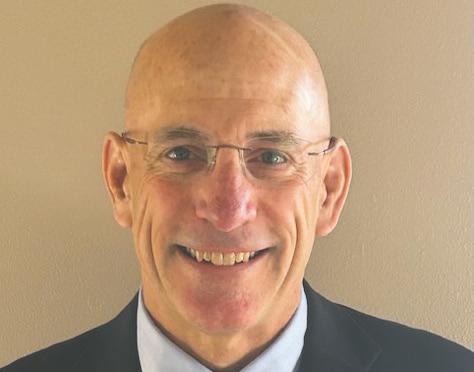
He collaborated with Montana Tech, mining companies, and tribal governments on projects involving carbon-free energy sources including wind, solar, and nuclear power. Morris decided to apply for the position after seeing the work the University, Montana Tech Foundation, and Lance family were doing to make a difference in the world.
Photo Credit: 5518 Designs
Bob Morris
Photo Credit: Dan Hoke, SE Communications
MNEWS SPRING 2024 9 8 MNEWS SPRING 2024

Hello Oredigger Family!
I hope this message finds you and yours well. Spring is such an exciting time for the Montana Tech campus, a time for new growth and opportunities.
In May, more than 300 Orediggers headed out into the world armed with a Montana Tech education and the grit and desire to make a mark and a difference.
Additionally, our students are setting off for many exciting summer internships. We value the relationships we have with our industry partners. Along with nearly $1 million in support this year, they offer priceless opportunities for students to experience real on-the-job education.
Avery Londo, a civil engineering student from Hilliard, Ohio, has completed two internships with Nucor. She believes in the importance of internships. “The internships not only prepared me for my future career, but also exposed me to experiences I would never have had otherwise. In my internships, I worked on real engineering projects and had leadership training from seasoned leaders in
the company. I also had the chance to live in different parts of the country and meet other interns my age from many different schools,” explained Londo.
It is proof positive that the education earned at Montana Tech matters in an ever-changing world. For nearly 125 years, Montana Tech has provided industry with the finest tier-one talent who are prepared to tackle any challenge and find solutions for today and the future.
Airika McClafferty, technical college recruiter for Nucor, added, “Over the past 10 years, internships with Montana Tech students have proven successful for Nucor due to the University’s experiential lab-focused curriculum, which equips interns with practical skills directly applicable to our industry. The combination of theoretical knowledge gained in Montana Tech’s classrooms and real-world experiences gained during internships has consistently produced highly competent and high-achieving full-time teammates.”
I am so proud to be part of the Montana Tech family. This academic year 2,000 of you provided over $6 million through scholarships, departmental investment, equipment, research, student club support, and state-of-the-art
resources to grow our campus impact and address the needs of our students, faculty, staff, and programs.
As an institution, we have stood the test of time by staying true to our core and expanding our footprint with in-demand education and innovation.
Your generosity and commitment to Montana Tech are one of a kind. What we can accomplish together is incredible. Let’s keep doing it!
Thank YOU!
Roll Diggs,
Jaime Heppler
Interested in learning more about how you can join the mission to support future Orediggers? Visit www.foundation.mtech.edu. CEO, Montana Tech Foundation
TOTAL RAISED TO DATE:
$7,269,658
TOTAL DONORS:
2,280 ALUMNI DONORS: 950 FRIEND DONORS: 1,004 CORPORATIONS: 279
FISCAL YEAR NUMBERS TO DATE
MNEWS SPRING 2024 11 10 MNEWS SPRING 2024
A Story of Success Stick Leg Ranch
By Megan Strickland
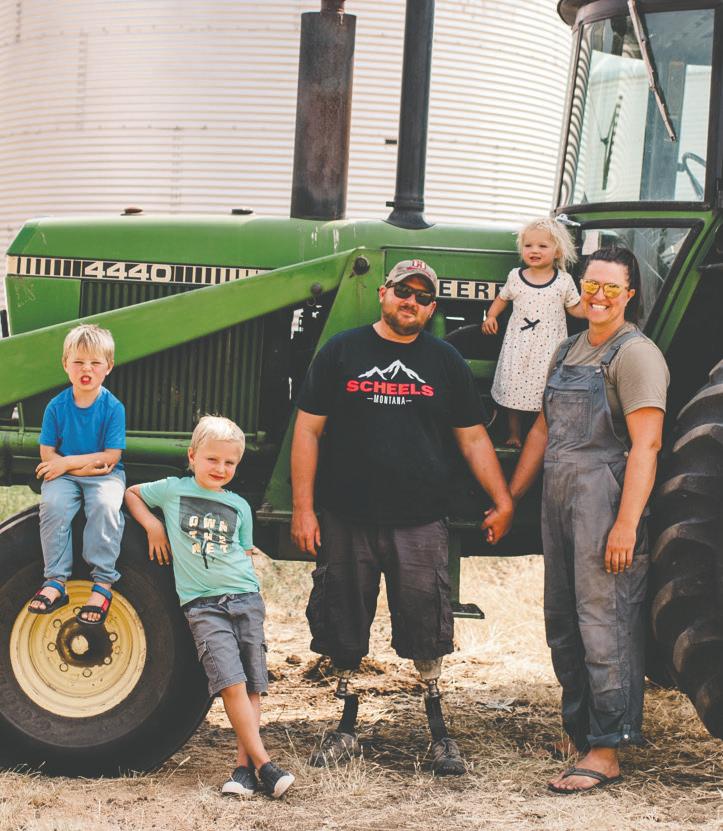
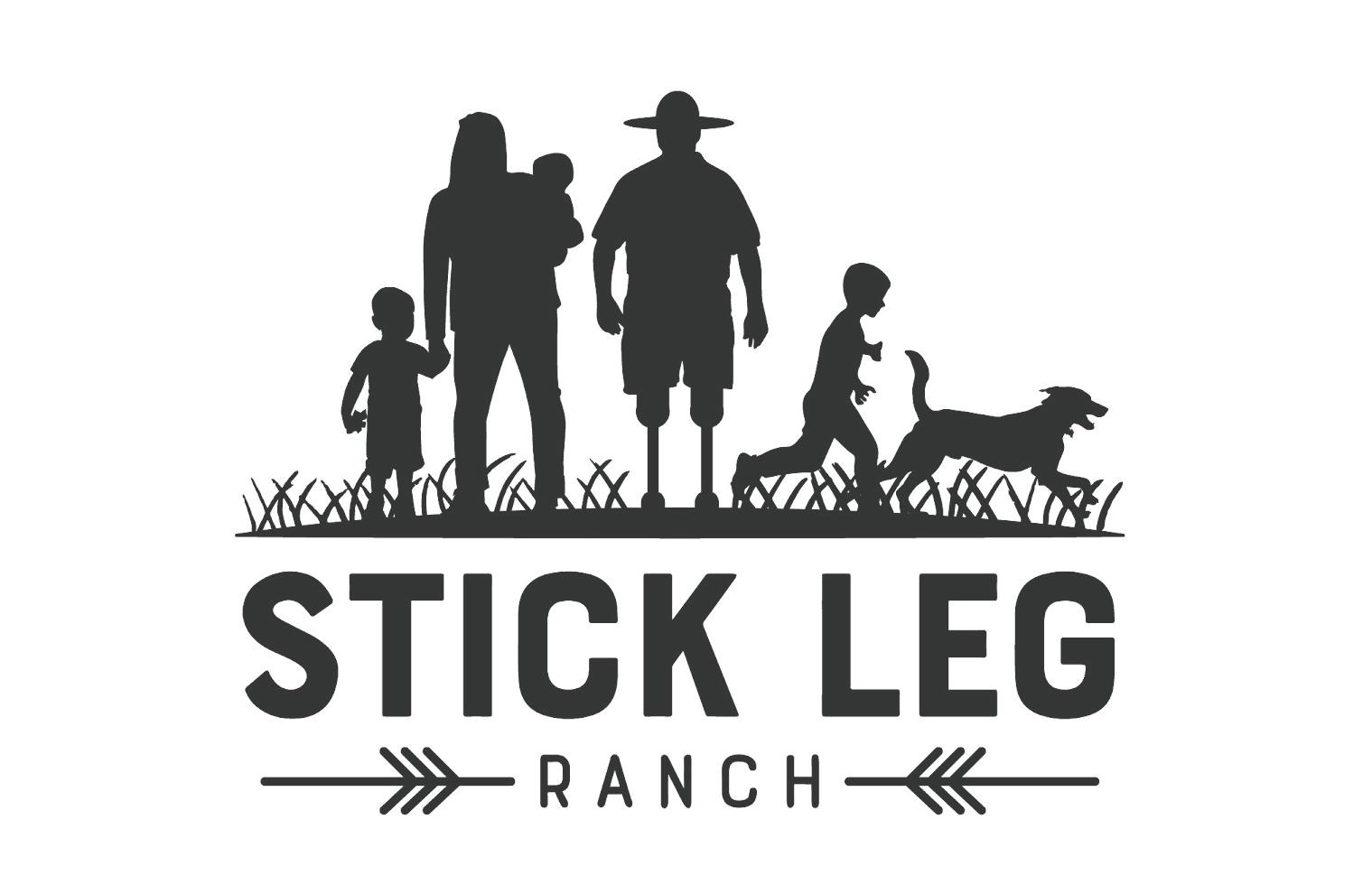
Seth Becker (Petroleum Engineering & Engineering Science, ’01) does not recommend losing one’s legs, but he jokes that if you are going to lose them, there’s no better community to have around you than the one at Montana Tech.
A quarter-century after Becker lost his legs in a drilling accident during a petroleum engineering internship in the Gulf of Mexico, he’s used good humor, perseverance, and ingenuity to build a successful regenerative ranching business with his wife Jennie. The Stick Leg Ranch ships and delivers high-quality Black Angus beef and Berkshire pork directly to customers around Montana and the United States.
Seth’s story starts in Conrad, Montana, a tiny town of 2,300 people an hour south of the Canadian border, where he grew up working on a local cattle ranch.
“I loved ranching,” Seth remembered. “I knew I wanted to come back and be a rancher someday.”

When high school graduation came around, Seth packed his bags for Butte, with practicality in mind.
“Montana Tech had really good job placement,” Seth said. “I wanted to be a veterinarian or I wanted to do engineering. Petroleum engineering had good starting salaries. Oil and gas were around where I grew up. I wasn’t trying to save the world or anything.”
Seth made lots of friends as an Oredigger. He spent a summer working in the oil and gas industry in Shreveport, Louisiana, and found that he enjoyed what he was doing and was right on track.
“College was top-notch,” Seth said. “How do you not fall in love with Butte?”
But in the summer of 1999, Seth was working on an offshore oil rig when a mechanical malfunction caused catastrophic and irreparable injuries. He was slammed against a wall. First his legs were broken, and then they were mangled beyond repair. Becker lost 9.5 pints of blood, which is 95% of the human body’s total blood volume. He almost died multiple times and spent weeks in the hospital. Beyond losing his legs, Becker suffered trauma to the head and other injuries that had long-term impacts.
Undeterred, Becker came back to campus. He had to fight off infections and learn to walk again with prosthetics. With the help of a local doctor and support on campus, Becker crossed the graduation stage as a double major.
“Everyone was wonderful,” Seth said. “All of the faculty and students were so helpful.”
Petroleum Engineering Department Head Dr. Todd Hoffman remembers Seth’s determination.
“Seth and I started at Tech together in petroleum engineering, and like everyone, I was devastated by the news of the accident,” Hoffman said. “It broke my heart, but when Seth came back to college, he had a great attitude. His grit and determination were inspiring.”
Engineering in the field wasn’t in the cards for Seth anymore. He went back home to Conrad, and eventually, after a long, drawn-out court battle, won a settlement that allowed him to purchase a piece of property.
“It was something I could handle,” Becker said. “I could do a lot of the maintenance myself.”
Eventually, Becker cleaned up the property, and launched his cow and calf operation. Becker’s dad came to work for him. Things were going well, but something was still missing.
In 2012, Jennie, a teacher from Salt Lake City, visited a ranch in Seth’s area through an acquaintance made on a rafting trip in the Grand Canyon. Jennie was happy with her suburban life, and did not think much of it when an area rancher named Steve Hutton and Lisa
MNEWS SPRING 2024 13 12 MNEWS SPRING 2024
Photos courtesy of Eliza Jayne Photography

Schmidt tried to set her up on a date with Seth. Still, she emailed Seth, and after the email went unanswered, Steve picked up the phone and gave Seth a push.
After emailing back and forth, Seth and Jennie decided to meet and go on a spring break camping trip. Jennie jokes she wouldn’t have typically gone on a camping trip for a first date, but she was pretty sure he wasn’t a murderer as friends recommended him. During that date, Jennie tried to push Seth to test his limits, by sending him down a terrible back road. She knew he was a legless rancher, so he obviously had mettle, but she wanted to see his personality in the face of immediate adversity.
Seth was not rattled and was able to laugh his way through it.
“I thought ‘This guy can handle anything at this point,’” Jennie remembered.
After long-distance dating for some time, it was time to make some choices. Seth was dragging his “feet” on a marriage proposal, so Jennie proposed. The pair tied the knot in 2014.
“I’ve never really looked back,” Jennie said. “We kind of jumped into life full steam. I was 30, he was 37. Life happened really fast.”
The Beckers added three children, chickens, turkeys, ducks, and pigs to their brood as they grew hay and raised cattle. But in 2020, after years of drought, the cow-calf operation wasn’t as profitable as it once was. Seth and Jennie started
thinking about how they could run a better business. They attended seminars on regenerative agriculture, and instead of only producing calves to send to market, they settled on producing high-quality grass-fed and finished beef and pork that would be shipped directly to the customer. The Beckers had to make some big changes to be successful. Instead of calving in the harsh winter, they let their cows give birth in summer, when the herd was out to pasture on green grass. They learned to work with nature to produce better beef. Jennie had to take classes to learn about business, and how to build a website, and she became a master at social media marketing.
Three years later, Stick Leg Ranch ships and delivers beef and pork to customers across the U.S., as far away as the East Coast. Jennie’s Instagram account @sticklegranch has more than 3,000 followers and details the ins and outs of life on the ranch. Products are constantly being added. Cutting boards, beef tallow soaps, and apparel merchandise are all available on the ranch’s website.
Jennie’s advice for running a successful business is to get going, and not to worry about what others might think.
“Just start,” Jennie said. “I wasted probably six months because I didn’t know where to start. You have to start, little by little. Expect yourself to fail and expect yourself to grow.
We have a saying around here, ‘hard things aren’t bad, they’re just hard’.”

Seth also has a few words of wisdom for the entrepreneur.
“Put out a product you believe in,” Seth said. “If you absolutely believe in your product, then it’s really easy to sell it. You want to shout it from the rooftops.” He says much success builds from Newton’s first law of motion.
“An object in motion tends to stay in motion, so get in motion and stay there and you really can overcome many things if you stay there. Keep moving and keep pushing,” Seth said.
Seth’s journey has continued to inspire those who know him.
“I’ve had the privilege to remain friends with Seth throughout the years and witnessed his growth both personally and professionally,” Todd Hoffman said. “A bunch of our college friends do an annual float trip down the Missouri, which has been a great way to stay connected and hear some of Seth’s great stories, from grizzly bears on his ranch to calving in a blizzard. He’s one of a kind!”
As he reflects on the incident in the Gulf that changed the trajectory of his life, Becker speaks about it with peace and acceptance.
“It’s just part of who I am now,” Becker said. “I don’t even think I’d take it back anymore, especially if it meant didn’t have my wife, kids, and life that I have now. Life would be hard if I didn’t have them.”
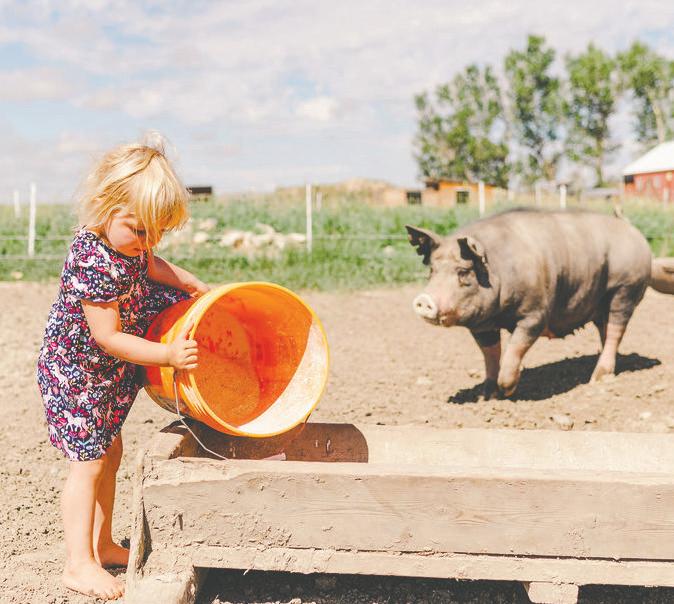


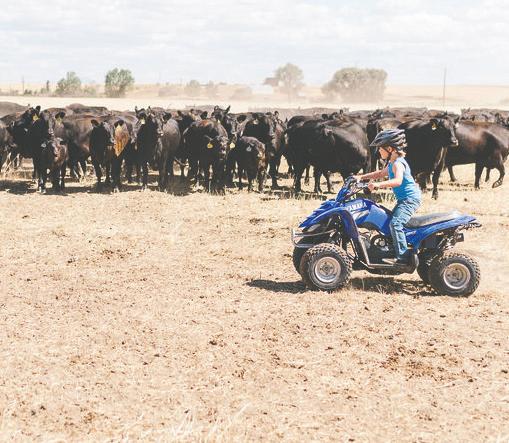
MNEWS SPRING 2024 15 14 MNEWS SPRING 2024
AISES Shoots for the Stars
 By Megan Strickland
By Megan Strickland

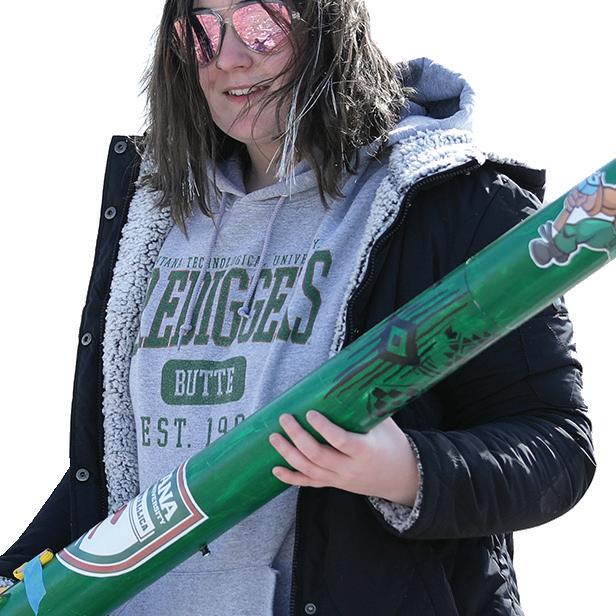
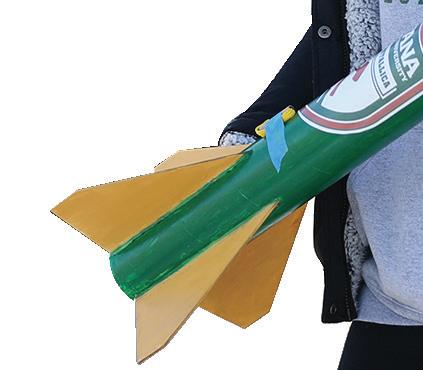

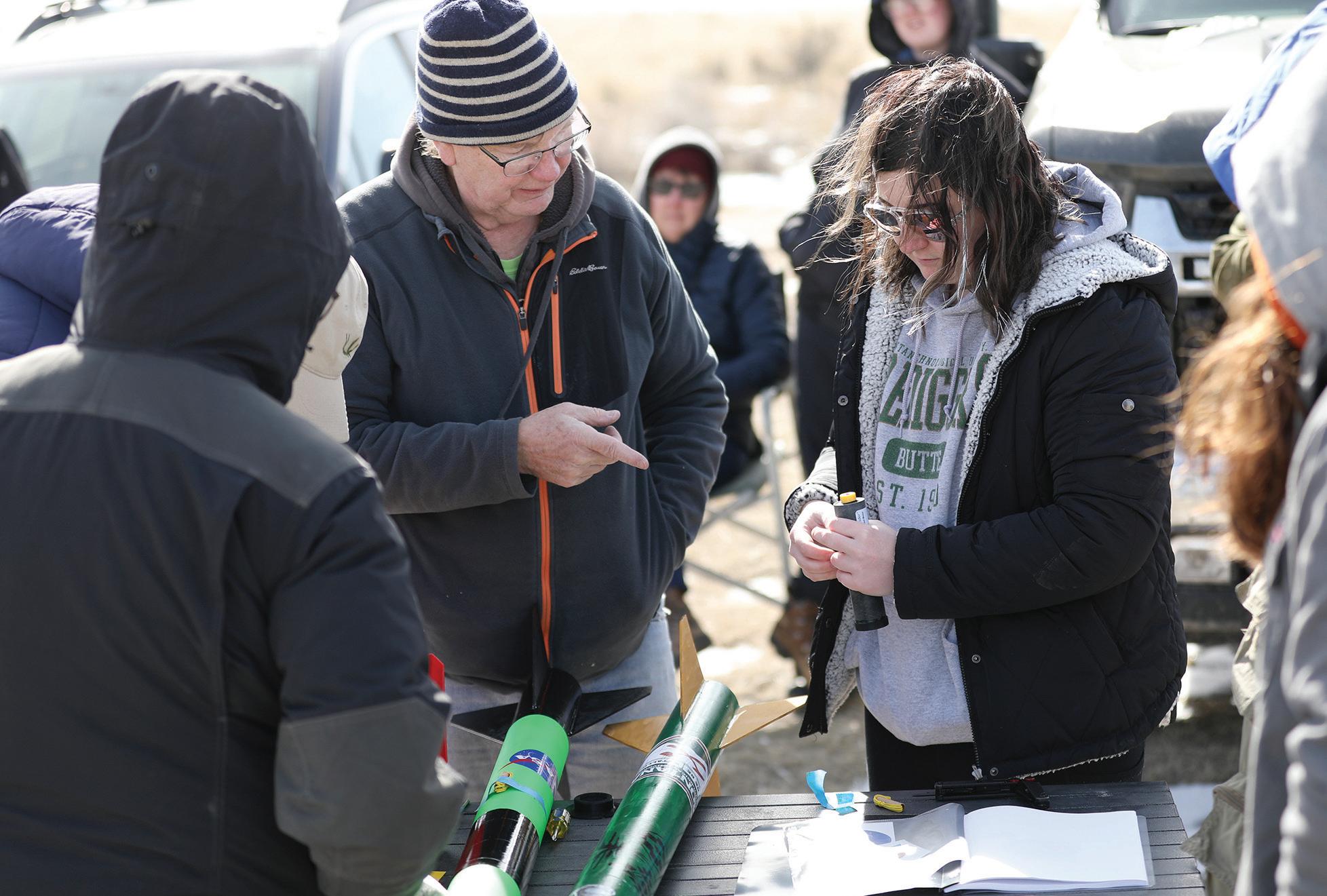
“We spent two days crafting this rocket,” Beplate said of the competition rocket. “We had to go through and learn all the parts. If we are going to be working with highpowered motors, then we really need to understand how everything
“We have little mercury strips we load in with a plug, then when we hook the battery up, it will send an electrical charge, ignite the mercury inside the motor, and ‘boom!’ It’s a chemical reaction,” Beplate said.
very time the Space Race has gained momentum over the past 70 years, Montana Tech Orediggers have answered the call to push the boundaries of their engineering skills to higher altitudes.
In April 1958, just weeks after the Jupiter-C, a modified Redstone missile, propelled America’s first satellite, Explorer 1, into space, Montana Tech students launched “Fystp,” a two-stage solid-fueled rocket that traveled 962 feet into the air.
In 1967, Montana Tech Professor Charles Herndon spent a summer working with the engineering team at NASA’s Huntsville, Alabama campus to determine the reliability of a hydraulic unit used to start the Saturn V, the rocket that carried crewed flights to the Moon. And in 2024, as the world watches NASA’s ambitious plan to return humans to the moon and build a basecamp on its surface through the Artemis program, Orediggers are once again setting their sights on the sky.
The Montana Tech Chapter of the American Indian Science and Engineering Society (AISES) is working with the
Wisconsin Space Grant Consortium, NASA, the Tripoli Rocketry Association, and National Association of Rocketry to launch a high-powered rocket, measuring 5 to 6 feet tall, more than 2,600 feet into the air above a launch site in Twin Bridges.
The practice launch will prepare the AISES team for the First Nations Launch High-Power Rocket Competition, to be held in Kenosha, Wisconsin. The Wisconsin Space Grant Consortium sends parts for the large rocket and a smaller practice counterpart that students must assemble.
Aurora Beplate is Vice President of Montana Tech’s AISES chapter. She is a freshman Mechanical Engineering student from Spokane, Washington, who is overjoyed to have the opportunity to participate in the First Nations Launch.
The Caliber ISP rockets, manufactured by Loc Precision, are designed to be reusable, with a parachute that allows them to land softly on the ground.
The Tripoli Rocketry Association will travel with the AISES team to Twin Bridges before the competition to conduct a test launch to ensure everything is working properly and is safe. If the test launch succeeds, the association will certify them at Level 1 in Rocketry.
“We have to have a safe takeoff and a safe landing, and we have to be able to pick it up and find it,” Beplate said.
“It’s pretty fun.”
The team was able to bond and learn about a smaller model rocket included in the kit, which they have launched multiple times at the base of the Big Butte Trailhead. The smaller rockets use a motor system that runs on mercury.
Post-baccalaureate Civil Engineering student Matthew Dang, from Fort Worth, Texas, says he joined the group to make the most of his time at Montana Tech.
“Rocketry isn’t part of civil engineering, but it’s interesting to me,” Dang said.
Jay Yoder, a senior in the Mechanical Engineering program from Raymond, Montana, has more professional aims in mind. He’s taken coursework at Montana Tech that dovetails nicely with rocketry.
“I like rockets,” Yoder said. “My ideal job is working on rockets at a defense company or at NASA. It’s a super interesting field. Rockets are inherently cool.”
The First Nations Rocket Launch took place April 26–28, 2024 in Wisconsin.
MNEWS SPRING 2024 17 16 MNEWS SPRING 2024
AWARDWINNING WINERY
By Megan Strickland

hen one thinks of being a vintner, or winemaker, it might conjure images of perfectly lit evening walks between rows of grapes, vaults of aging barrels, and tables of folks sharing laughs over full glasses of their favorite variety. Sarah (Morris) Lathrop (B.S. Professional and Technical Communication, ’02) loves owning Liberty Lake Wine Cellars, located in a suburb of Spokane, Washington, but she is quick to rip off the Rosé-colored glasses when she describes her work.
“Winemaking is a lot of work, physically and socially. Most people think of winemaking as romantic, like walking through a vineyard with a glass of wine, but we only walk through the vineyards when we’re checking on our grapes, and boy are vineyards dusty!” Lathrop said. “Winemaking is 80% moving cases of wine from one spot to the next and power washing.”
Lathrop knows what it takes to run a successful winery. In 2023, Liberty Lake Cellars was named Washington State Winery of the Year by Washington State Wine Awards, shortly after being named the 2022 Washington Winery to Watch by Great Northwest Wine. In January 2022, Liberty Lake went 7-for-7 at Great Northwest Wine’s Platinum Awards, which was an unprecedented win in the organization’s 22-year history of judging.
“We are a minimal intervention winery,” Lathrop said. “We don’t use additives in the winemaking process, we don’t make must
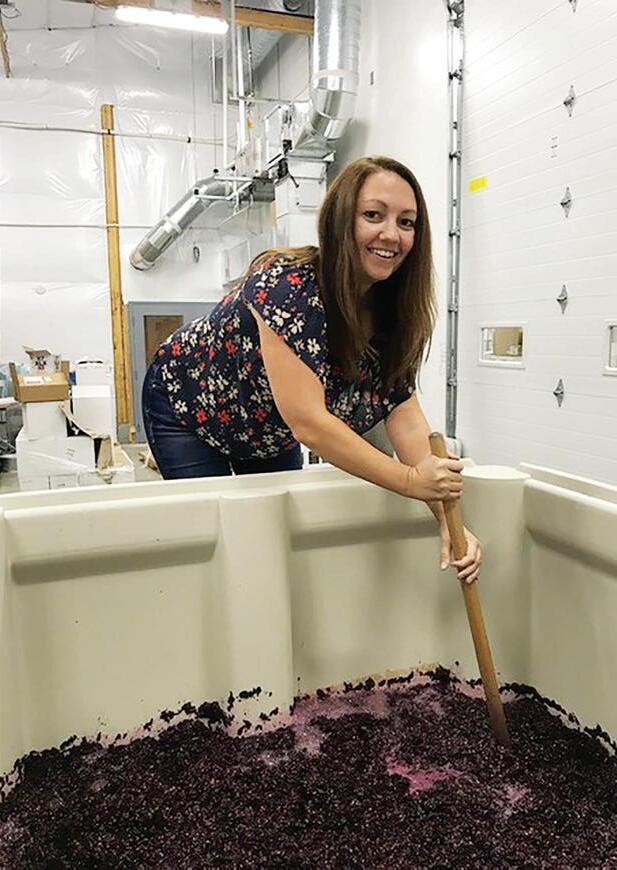

adjustments, we don’t filter our wine, and we use gravity to move wine during the racking and bottling process. Our philosophy is that if we purchase the best grapes that we can, they will produce a superior wine. It’s a philosophy that we carried over from the first winemaker and so far, it’s been successful for us.”
Liberty Lake produces small lots of 14-16 different wines, giving the customer a variety of choices.
“When people come into the tasting room, they’ll often see a different lineup of wine,” Lathrop said. “It makes the education part of wine fun on our end introducing people to a new variety they may have never heard of such as Carmenere, Petit Verdot, or one of my new favorites, Tourgia Nacional.”
Liberty Lake’s stellar winning streak and affinity for business s the culmination of a 20+ year journey that started in Butte, Montana. Lathrop grew up in the Mining City and decided to stay close to home when she graduated from high school. She attended Montana Tech, majoring in Professional and Technical Communication with a minor in Business, because she enjoyed writing.
“It was so much more than writing,” Lathrop said. “We had classes in photography, videography, web development, journalism, etc. Plus, our professors were from all over the country and brought such a great perspective to Tech.”
However, the job market when she graduated in 2002 was not the best for an entry-level candidate.
“I really wanted to move to Seattle, but instead I was lucky enough to get a job at J-U-B Engineers in Coeur d’Alene, Idaho in June of 2003,” Lathrop said. “When I started, I split my time as the executive assistant to the president and a marketing assistant for their subsidiary company Civic Mind Media. I worked there two years before leaving with my boss, Jim Coleman, to help start his civil engineering firm, Coleman Engineering, and at the same time I started my MBA at Eastern Washington University.”
Lathrop met her husband, Mark, while earning her MBA.
“Since meeting, we had always talked about owning our own business, and during our dating and after our wedding, all of our dates, vacations, et cetera seemed to be centered around wine,” Lathrop said.
The pair were wine club members at Liberty Lake Wine Cellars from 2008 to 2015, when they noticed the owners weren’t making wine.
“In September, we emailed them to ask why and they indicated they were going to sell the remaining wine inventory and close the winery,” Lathrop said. “We asked if they’d stay on for a year to teach us the winemaking process, they said yes, and by January 2016 we owned the winery. We both still had full-time day jobs until a few years ago. I went part-time at Coleman Engineering in 2020, and Mark became a full-time winemaker in March of 2023.”
Sarah’s duties at the winery include running the tasting room, managing staff, marketing/advertising, financials, and assisting with production during harvest and bottling seasons.
“We’ve made it successful by working extremely hard, not giving up, knowing how to pivot, and being very creative,” Lathrop said. “Our original projections were that we could both quit our day jobs in 2020, and we were right on track, and then COVID hit.”
The hospitality industry was shut down for
six months and Liberty Lake’s tasting room was forced to close.
“Many wineries in Washington ended up shutting down, but we didn’t give up,” Lathrop said. “We got creative with our marketing, making weekly fun packs for our customers—one week it was a movie pack with a bottle of wine, movie snacks, and our staff’s favorite movie picks, another week we partnered with a caterer for date night at home with to-go meals and wine, another week we did grab bags of library wines where our customers didn’t know what they were getting until they picked their bag.”
That creativity continued after COVID.
“We created a night each week for our wine club members,” Lathrop said. “Each week, we offer a special and at least once a month something silly or educational or entertaining. I’m not aware of another winery in the state that does that. We have plans to do a March Madness contest so those members who can’t join us in the tasting room can be involved.”
The couple also improved efficiency in all processes to handle duties alone if needed. It was a challenge, but Lathrop is not one to back down. Her history of running head-first at discomfort to achieve results is long.
“When I first started my career at the engineering firm, I was one of a very small number of women, most of whom were administration staff,” Lathrop said.
“I was hired to be the executive assistant to the president, which quickly led to helping with project management for our Wyoming School Facilities’ contract. Lots of travel to Wyoming often had me as the only woman in a room full of much older men. It was hard to be taken seriously, and it took years to win them over. I had to learn to stand up for myself so that I’d be heard.”
Lathrop continued to push herself by putting extra hours into education and networking.
“I took any opportunity I could to advance myself, which led to me getting my MBA, getting additional certifications, and volunteering on boards to meet people in my community,” Lathrop said. “I was part of the Coeur d’Alene Chamber of Commerce’s Education Committee for 10+ years; I was on the Montana Tech Alumni Board for 8 years (I resigned in May 2023), and I’m currently the treasurer of the Spokane Winery Association. I am naturally an introvert, and putting myself in these situations was very difficult, but it has allowed me to meet many interesting people, gain mentors, and gain respect from others in my industry.”
Wherever the future takes her, Lathrop carries the lessons she learned at Montana Tech with her every day, along with the work ethic instilled in her by working in her parent’s Butte businesses from an early age.
“I think Butte and Montana Tech go hand in hand,” Lathrop said. “There’s a certain amount of tenacity that goes along with this place. Everyone is expected to work hard and do whatever it takes to get the job done. I remember professors giving us assignments that seemed impossible, but if we had problems and needed extra help they were happy to meet us during their time off. This has definitely carried over into the winery. There is no job at the winery that I would ask my staff to do that I wouldn’t do myself.
You’ll find me at the winery cleaning out bins and then hosting a wine dinner, all within a few hours.”
MNEWS SPRING 2024 19 18 MNEWS SPRING 2024

Beauty, Science Emerge in Nanotech Lab
By Megan Strickland
o the untrained eye, the breathtaking images generated in the Montana Tech Nanotechnology Laboratory (MTNL) resemble painted masterpieces possibly inspired by Pablo Picasso’s works in cubism—but to the students who created them, these micrographs hold much more critical data than that of simple abstract beauty. Clues about structure and composition can be gleaned to learn more about the optical, electronic, or mechanical properties of materials students work with, which could be critical building blocks to solving some of the world’s most pressing issues.
If you ask Materials Science Ph.D. student Xavier T. Vorhies if he’s doing science or making art in the lab, his answer is simple and direct.
“What we make, and do, is arguably an artform,” Vorhies said.
Vorhies, from Olney, Montana, and Earth Science and Engineering
Ph.D. candidate Amos Taiswa, from Kilgoris, Kenya, recently won awards for their exceptional micrographs, or digital images taken through a microscope, presented at the International Conference on Electron, Ion and Photon Beam Technology and Nanofabrication (EIPBN). The EIPBN is the preeminent meeting for nanotechnology researchers and scientists from around the world, who come from
academia, government, and industry to discuss recent trends and the future of small-scale phenomena and devices.
Each year, the EIPBN community holds a competitive micrograph contest. Investigations at the micro to nanoscale depend on microscopes to observe small-scale phenomena and morphologies and to evaluate performance. To highlight this important characterization method, the EIPBN micrograph contest seeks submissions that exhibit intrinsic beauty and/or excite curiosity. All entries were evaluated based on technical and artistic merit by a distinguished panel of judges.
“The judging is done by some of the best nanotechnology scientists in the world,” said Dr. Jack Skinner, director of the MTNL, and head of the Department of Mechanical Engineering.
Vorhies won for the Best Electron Micrograph for his micrograph entitled The Wheat from the Chaff and the Grand Prize for his micrograph entitled Nano Cubism.
Taiswa won an honorable mention award for his micrograph entitled Banana Slug.
The images are the best each student has generated after countless hours in the laboratory’s clean room, which consists of a powerful
MNEWS SPRING 2024 21 20 MNEWS SPRING 2024

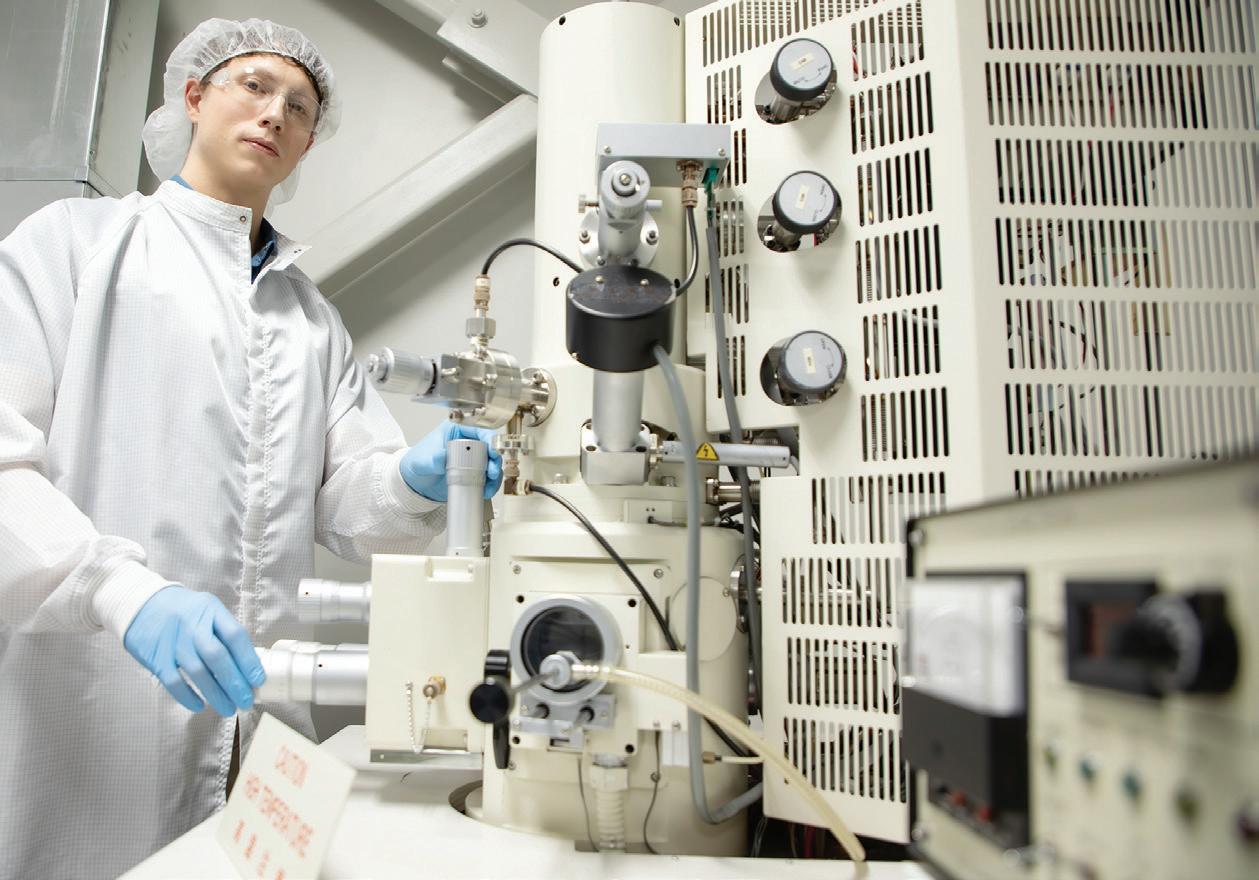
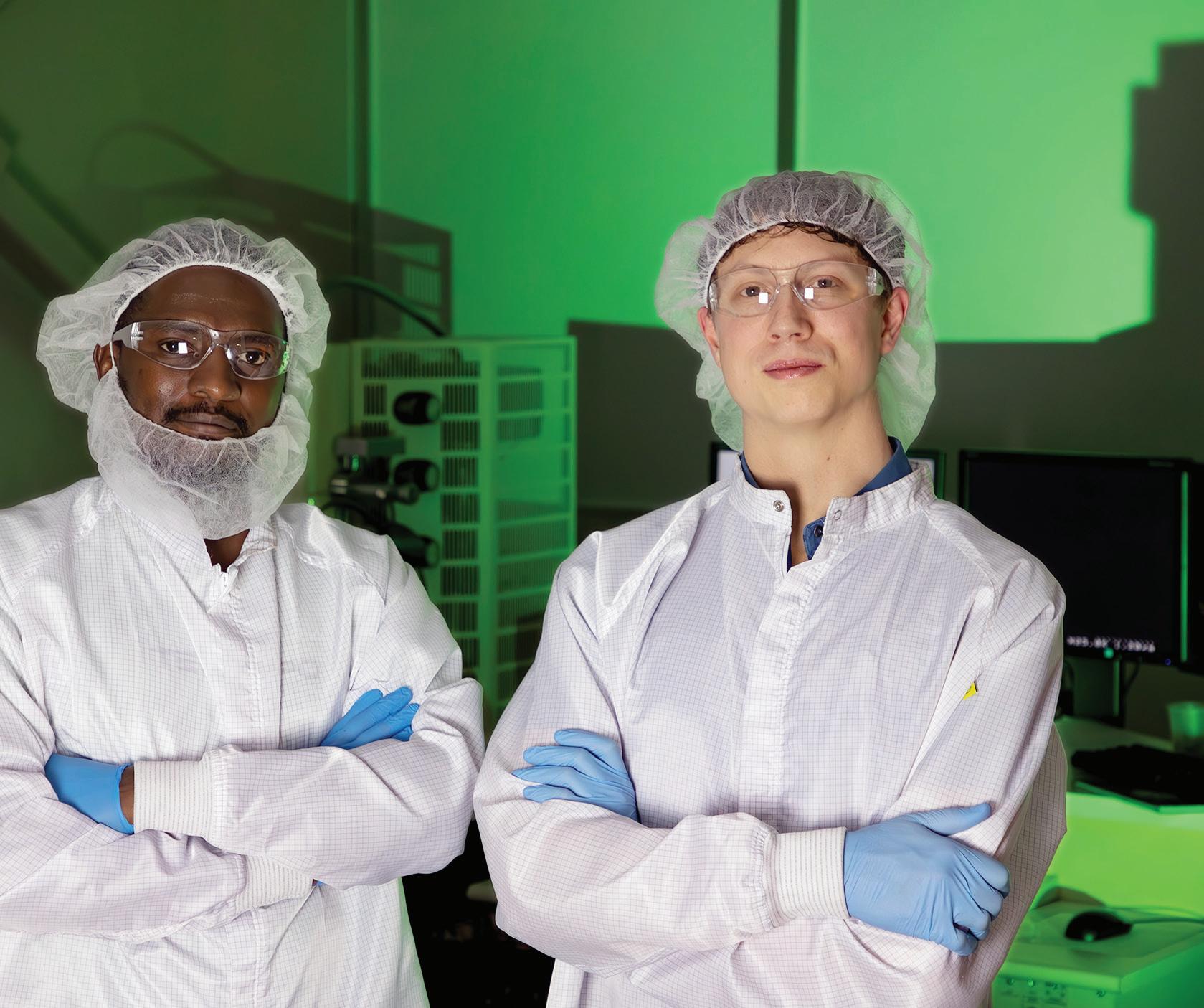
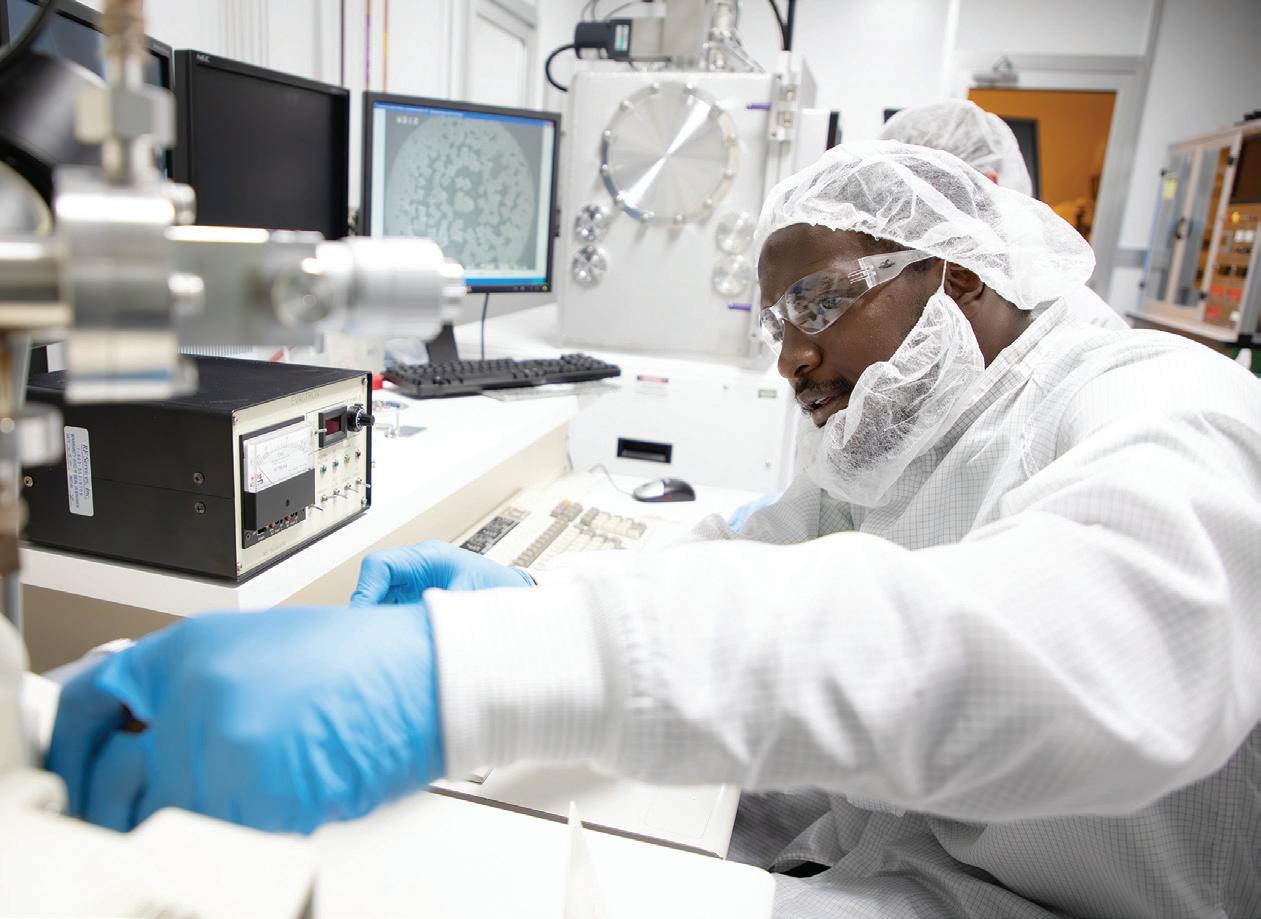
scanning electron microscope and a transmission electron microscope protected by a locked door and air technology that limits particulate matter. Researchers who use the lab have to wear “bunny suits,” white suits that cover them from head to toe and limit contamination.
“When working at the nano scale, one billionth of a meter, something as small as particles of dust or a stray piece of hair, could completely ruin your sample,” Vorhies said.
The processes Vorhies and Taiswa use to create their samples are fascinating. Vorhies grows materials used in solar cells called perovskites in a liquid solution on fragile thin sheets that are then inserted under the microscope. Taiswa uses a bioinspired method called electrospinning to create samples that mimic those of spiderwebs. His goal is to create materials that can be used for water purification.
“Where I grew up, there was scarcity, of everything, really,” Taiswa said. “I wanted to work on something that might provide a broader impact on building more sustainable communities.”
Taiswa notes that while the photos he and Vorhies submitted are artistically captivating, they don’t necessarily come from materials that were on target scientifically.
“Some are from failed experiments, but the micrographs look very interesting,” Taiswa said.
But every failure provides valuable information for future attempts. Both Taiswa and Vorhies have spent significant time in the nanotech lab, preparing and looking at their samples. They say easy access to high-powered electron microscopes helped attract them to Montana Tech. Students who work in the MTNL learn valuable skills that are highly competitive with much larger and more renowned institutions. In addition to electron microscopes in the MTNL, Tech is home to the Center for Advanced Materials Processing (CAMP), which has multiple scanning electron microscopes, and the Electron Microscopy Laboratory, which is home to a state-of-the-art Hitachi HT7820 scanning/transmission electron microscope that arrived on campus in May 2023, and is one of the most advanced instruments in the region. The Hitachi HT7820 was funded by a $1 million award from the National Science Foundation.
Vorhies said he was exposed to the electron microscope as an undergrad, which helped set him on the path to his Ph.D.
“We get a lot of recognition for our work at conferences, but that’s because of the amount of access and hands-on experience that we have in the laboratory,” Vorhies said.
Skinner said granting that kind of access to students has been a key part of a five-year effort to create and elevate the MTNL’s capabilities and recognition.
The laboratory has racked up a string of accolades and publications in its five years of existence.

“When working at the nano scale, one billionth of a meter, something as small as particles of dust or a stray piece of hair, could completely ruin your sample.”
In 2021, Materials Science Ph.D. student Luke Suttey won the EIPBN’s Grand Prize for his micrograph entitled Pretzel Sticks. The micrograph depicts electrospun polymer filters that were fabricated during the pandemic to accommodate the increased demand for novel mask materials. That same year Dr. Jessica Andriolo won the Most Bizarre micrograph for her image entitled Dr. Seuss Coloring Book, and an honorable mention for a second micrograph entitled Where’s Mickey?
Researchers have published work in The Journal of Vacuum Science and Technology B; The Journal of Physical Chemistry B; Water Supply, Coatings, Separation and Purification Technology; and MRS Communications, printed by the Cambridge University Press.
“I never would have thought we would be able to do this,” Skinner said. “We interact with peers all over the world. Our students go to conferences with these massive, internationally known schools and laboratories, they get job offers, they collaborate. That’s the goal. The goal is for us to be invited to the table and be a peer institution that brings something to the table.”
Skinner is a Butte native (B.S. General Engineering–Mechanical Option, ’00) who went on to get his M.S. degree from Washington State University, Pullman, WA, in Mechanical Engineering in 2002, and a Ph.D. from the University of California, Davis, CA, in Mechanical
Engineering in 2007. He was a graduate student researcher at the Berkeley Sensor and Actuator Center (BSAC) at the University of California, Berkeley from 2004 to 2007, where he developed diffractive optical microsystems. From 2003 to 2012, he was with Sandia National Laboratories in Livermore, California.
While Skinner had to leave Butte to find more opportunities, he hopes students like Vorhies and Taiswa see the Mining City as a potential long-term home for their scientific endeavors, rather than leaving for Silicon Valley or another major international city.
“If you don’t want to leave Butte, you don’t have to leave,” Skinner said. “We’re working on proposals that would help build the local economy. We patent our work. We are here to change things, and offer more to our students, to our community.”
Vorhies would like to work for a national laboratory as a scientific researcher, and Taiswa has a plan to perhaps stick around Butte a little longer before tackling a lifelong dream: of pursuing a political career in his home country of Kenya.
“Our students can go anywhere and be successful,” Skinner said.
MNEWS SPRING 2024 23 22 MNEWS SPRING 2024
Teaching a Robot to do the Dirty Work
By Megan Strickland

MNEWS SPRING 2024 25 24 MNEWS SPRING 2024

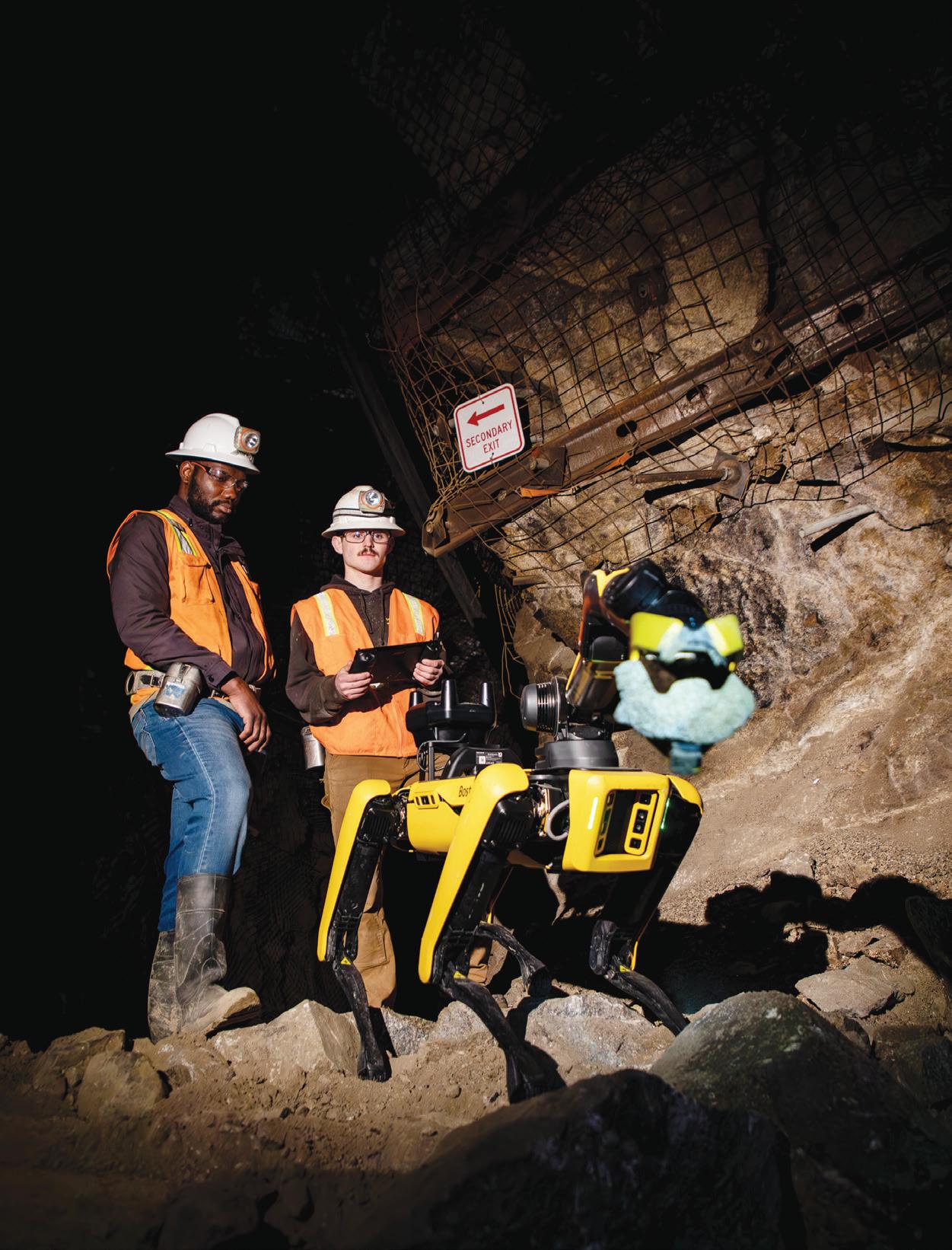
he U.S. Department of the Interior estimates there could be as many as 500,000 abandoned mine sites on federal land, and researchers at Montana Technological University’s Mining Engineering department are using novel robotic technology to see if any of those already disturbed sites might hold critical minerals.
“The United States at this moment does not have access to near the amount of critical minerals that are needed for the next stage of advanced electronics,” Associate Professor of Mining Engineering Dr. Abhishek Choudhury said. “China has about 60% of critical and rare earth mineral production and 85% of the processing capacity. The U.S. hasn’t even explored what exists within its boundaries, and in a lot of mines in the mountain west, they historically did not look for these critical minerals. We might have many of these mines around that have these minerals.”
Choudhury and his students are training a $295,000 “SPOT” robot from Boston Dynamics to go where it is unsafe for humans to explore in these abandoned mines. The project is funded through a Cooperative Agreement with the DEVCOM Army Research Laboratory, which has supported more than a dozen projects on Montana Tech’s campus in pursuit of building a domestic supply chain of critical minerals. The funding has been made possible through the efforts of Senator Jon Tester, chairman of the Senate Defense Appropriations Subcommittee, who has championed Montana Tech’s collaboration with military organizations in recent years. That collaboration has facilitated access to cutting-edge equipment, facilities, and research that would not otherwise have been possible.
The robot arrived on campus in November 2023. SPOT has four legs, and is about the size of a large dog. It can sense and avoid obstacles, climb stairs, and open doors. It has found a home on factory floors and warehouses, but Choudhury wants to take it underground, where travel is much more difficult.
“If your robot can survive an underground mine, it can survive anywhere, with the possible exception of Mars,” Choudhury said.
Choudhury’s students traveled to Boston Dynamics’ facilities in Massachusetts to be trained in operating SPOT. Mining Engineering Junior Arlo Eades, of McArthur, California, said it was an incredible experience.
“It isn’t every day that you get to see the very place where cutting-edge technology is being developed and tested,” Eades said. “Bringing that very same technology to an underground environment is an exceptional opportunity to push it to its limits.”
Choudhury’s team must teach the robot to do a task more complicated than walking or opening a door. They are working to program SPOT to walk into the mine and drop a series of radio transmitters that will extend the robot’s range to communicate below the earth’s surface. They then want the robot to collect samples of rock within the mine. One challenge is integrating software that will tell the operator exactly where samples were collected.
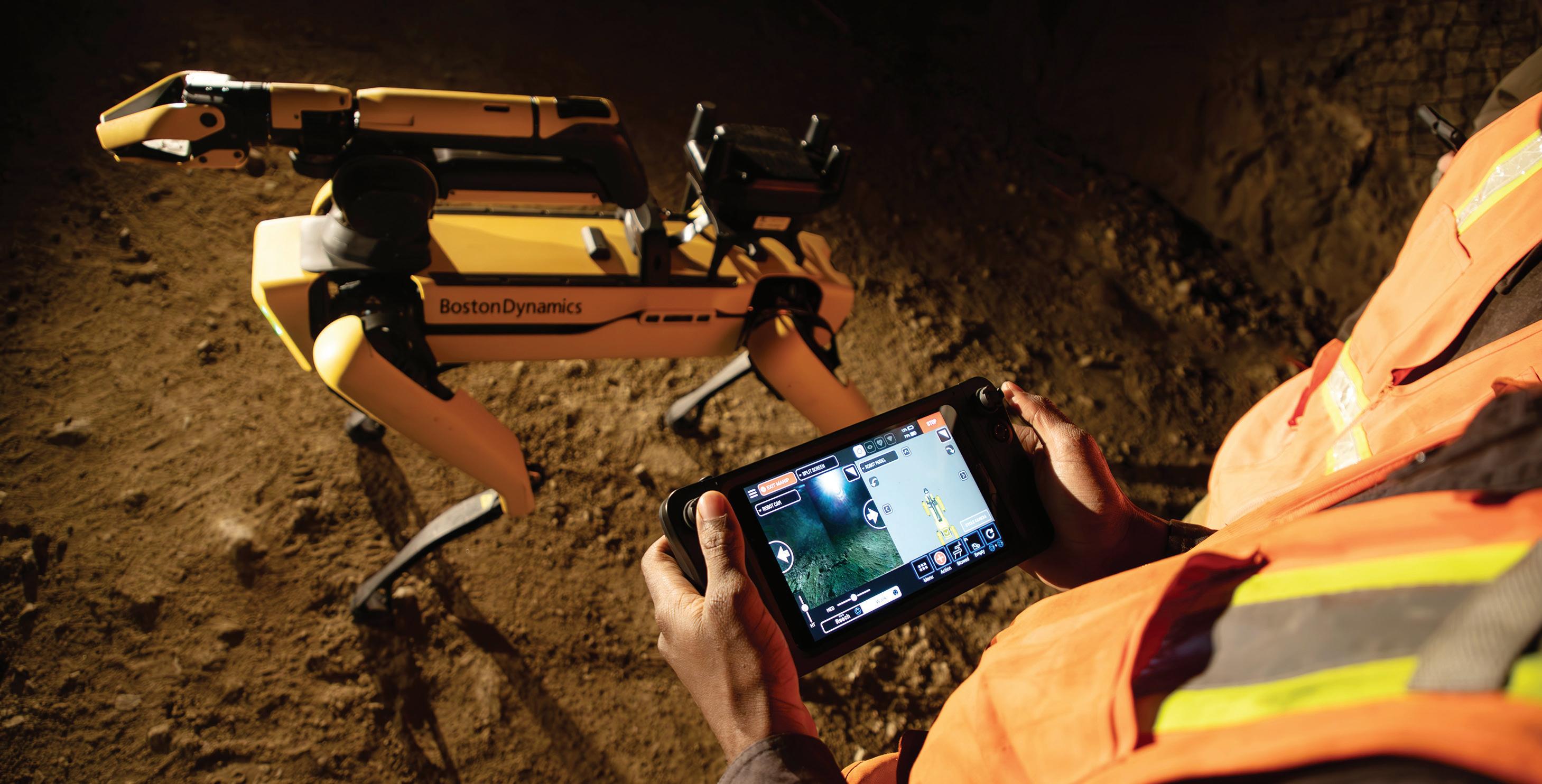
“It isn’t every day that you get to see the very place where cuttingedge technology is being developed and tested,” Eades said. “Bringing that very same technology to an underground environment is an exceptional opportunity to push it to its limits.”
step is to autonomously walk it all the way into the mine and perform simple tasks.”
Kodis Campbell is a Mining Engineering Junior from Spring Creek, Nevada.
“This project has helped me better understand project planning and the ability to balance other outside factors,” Kodis said. “Another great feature of this project is the coding that will be required in future development. The world is becoming increasingly digitized and the ability to code is becoming more valuable.”
Choudhury says the rise of artificial intelligence and robotics makes it even more important for students to understand the “why?” behind their engineering, since machines are currently trained to answer the more straightforward questions.
“It’s a far more fundamental level of query,” Choudhury said.
“If you collect a sample that has critical minerals in it, it is equally important to know exactly where in that mine you picked the rock up,” Choudhury said.
Alan Arthur is a graduate mining engineering student from Accra, Ghana, who says training the robot to autonomously document a sample’s location has been the most challenging part of the project so far. The team is utilizing the Underground Mine Education Center (UMEC). The UMEC is a hands-on, interdisciplinary educational space consisting of the former Orphan Boy and Orphan Girl Mines located immediately west of campus.
“The biggest accomplishment so far is being able to autonomously walk the robot to the portal of the UMEC,” Arthur said. “The next
For this particular project, a mining background is invaluable.
“You need to know what problems might come up in a mine,” Choudhury said.
If Choudhury’s research team is successful, and SPOT can find critical minerals in abandoned mines, it could mean big business for southwestern Montana, where ghost towns of abandoned mining communities are numerous.
For now, Choudhury is focused on training SPOT, and building a research group with more members. Students who are interested can contact him at achoudhury@mtech.edu.
MNEWS SPRING 2024 27 26 MNEWS SPRING 2024


Building Dreams
By Megan Strickland
When Andy Larson was in high school, his mom signed him up for a summer internship with a homebuilder in Utah.
The teen was hooked, and Larson knew he wanted to make construction a career. Highlands College landed on his radar when the family moved from Utah to Ennis. The hands-on nature of the program at Highlands College was a big selling point for Larson.
“My favorite part of this program is taking what you learn in class and immediately putting it into practice,” Larson said. “You aren’t sitting in a lecture hall. At Highlands, you don’t learn staring at a computer screen. If you go out and do it, you learn a lot better. You learn about concrete in class, and then we go out and pour the sidewalk in front of the college and finish it. It’s so nice to see what you are learning.”
Andy has served as a Prospector, Montana Tech’s student ambassador program. He also represents Highlands College as a member of the Associated Students of Montana Tech, Montana Tech’s student government. He is set to graduate in May 2024 with his AAS in Construction Technology–Carpentry. His cohort of students is the first where instructors Rich Miller and Mike Fink have created a 2-year curriculum that revolves around building a 3-bedroom, 2-bath modular home from start to finish, including reading blueprints, site layout, framing, CAD design, and completing interior and exterior finishes. Students also learn how to be savvy businesspeople, with classes in business law, accounting, and estimating costs.
“We try to tie all of the classwork back to building the house,” Miller said.
The first house will be completed in May 2024, with another also under



construction. As the program does more work, the instructors are honing in on the best building techniques for their design. For instance, the first group built a gable, but the second group found it was more cost- and time-effective to order it and install it instead. This spring, Fink and Miller developed criteria for how to offer the homes for sale. The idea was to work with the city–county government or Habitat for Humanity to help alleviate housing shortages in the community. Highlands College wants to sell the home at cost for a good cause.
“We don’t want it to become a vacation rental,” Miller said. “We want to ensure it
addresses the issue of limited affordable housing in Butte–Silve r Bow.”
The structure is built to be lifted by a crane and shipped to its final homesite. Students get to vote on which finishes they would like to install, and can add their own flair to the projec t. There are 16 students set to complete the first house, and 28 students, in the second cohort, will finish their modular home n May 2025.
Miller says graduates are highly employable. “There has been a construction boom in the past few years,” Miller said. “Our students can find work almost anywhere.”
By February, Larson had his summer plans set to intern with Langlas & Associates. Larson has enjoyed multiple summer internships so far, and has participated in projects including a 14,000- square-foot, high-end, multimillion-dollar luxury home, and work at the internationally known Yellowstone Club.
Larson says it’s neat to drive through neighborhoods around southwestern Montana, see his handiwork, and take pride in having been a part of creating something that was built to last.
“It’s nice to do work that will stand for years to come,” Larso n said.
MNEWS SPRING 2024 29 28 MNEWS SPRING 2024
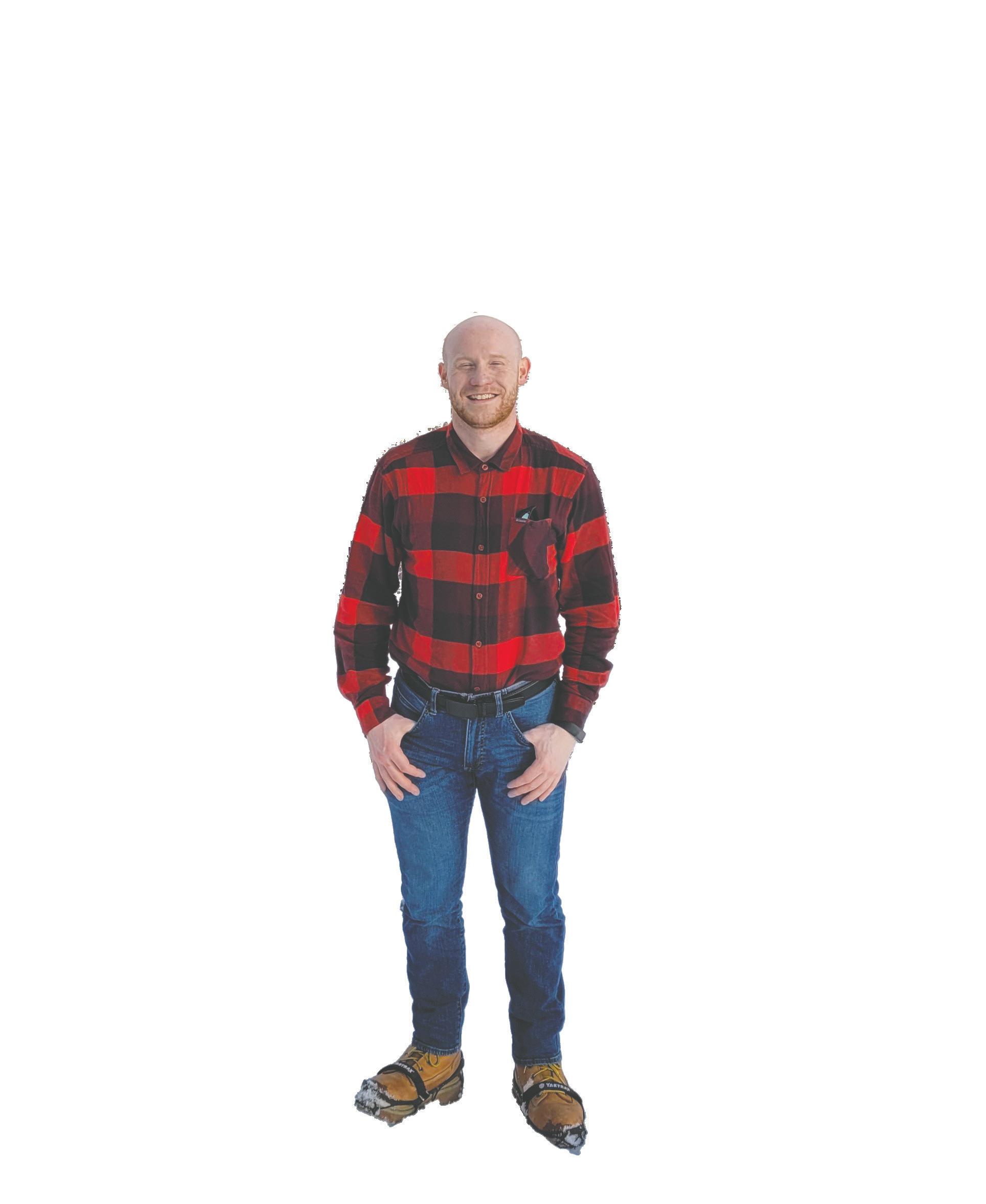 Bob Hark
Bob Hark
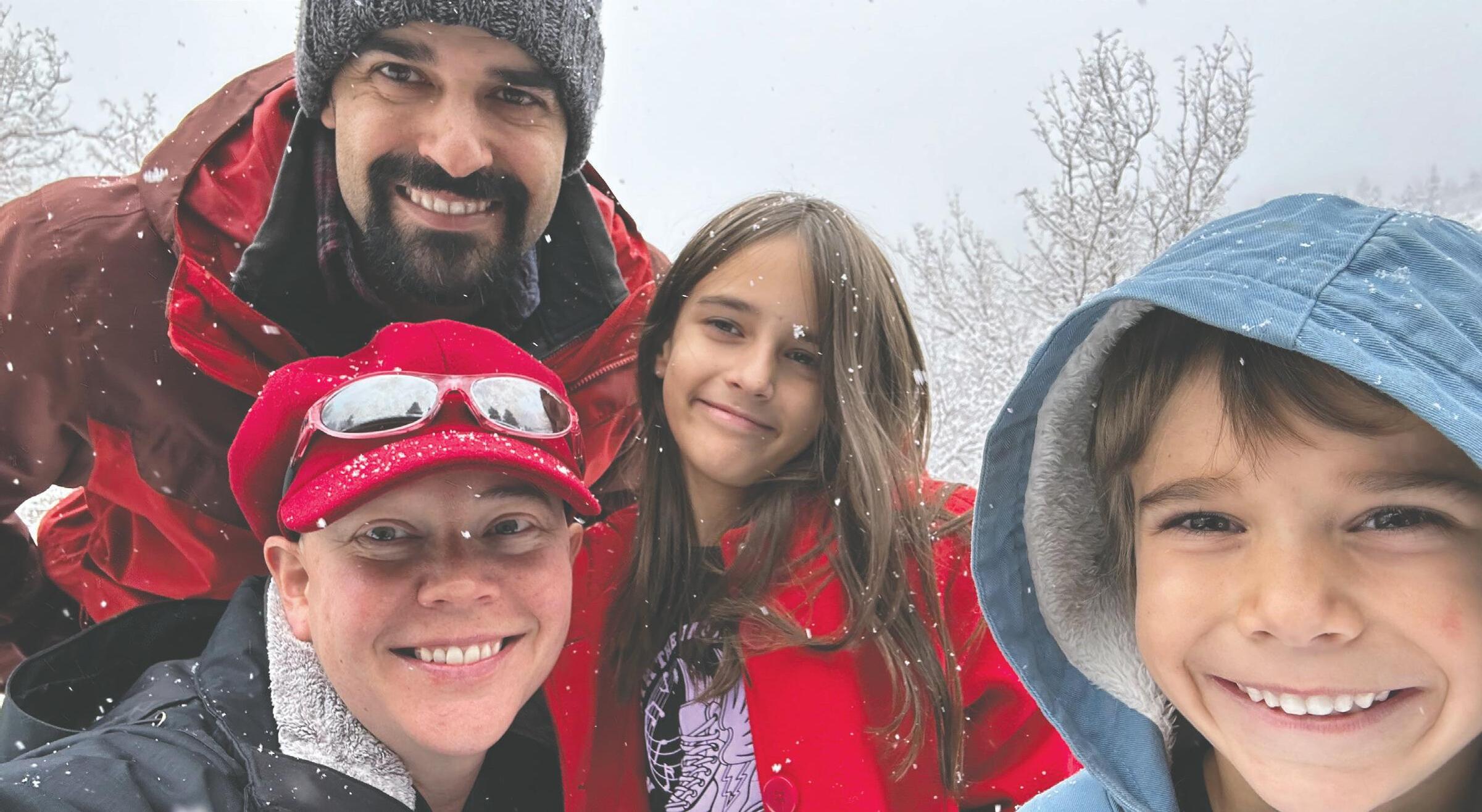
Montana Tech’s history is steeped in mining.
In the fall of 2005, then-chancellor Dr. Frank Gilmore initiated the National Student Awards Committee (NSAC) to mine for the highest level of student recognition available nationally. NSAC focused on the Goldwater Scholarship, long recognized as the premier undergraduate award for science, math, and engineering. The Goldwater program was established by Congress in 1986 as a key part of the Barry Goldwater Scholarship and Excellence in Education Foundation. Annually, about 400 sophomore and junior students with potential for transformative careers in the natural sciences, mathematics, and engineering are recognized as Goldwater Scholars. Dr. Gilmore eventually became the President of the Goldwater Foundation.
Dr. Marisa Pedulla was selected as the first chair of the committee and has continued to serve since. “Nineteen years guiding NSAC have been very fulfilling, working closely with outstanding, dedicated committee members and over three dozen extraordinary Montana Tech students. Getting to know the students and watching them grow as they formulate many iterative drafts of essays that require deep self-contemplation, research interests, and career trajectories is very rewarding,” she said. Pedulla went through the national award process herself when she was an undergraduate student at the
University of Pittsburgh and was nominated for the Rhodes scholarship. Paying it forward has been part of her purpose. In the 100 years prior to the NSAC, Montana Tech had one student recognized with this prestigious honor, Calley Jones (2000). Since NSAC was formed, 11 Montana Tech students have been honored, and an additional 5 have received honorable mentions.
The first two Goldwater Scholars since NSAC started were both graduates of Mathematics.
Chris Dienes (2007) completed his B.S. in 2008 before going on to earn his Ph.D. in Statistics at UC Davis in 2013. Chris now works as a data science manager at Amazon. Prior to Amazon he was a data scientist on research and development teams for both government and commercial organizations. While no longer working directly in research, he says, “I still leverage my knowledge of research while coaching junior scientists or setting the strategic direction for my applied science and software engineering teams.”
Dienes is now a parent of two, Harper (8 years old) and Austin (6 years old). “I encourage them to explore their passions and curiosities,” he said. “By diving deep into their open questions, they not only cultivate their interests, but also learn critical research skills such as navigating ambiguity, establishing hypotheses, deconstructing problems into manageable parts, and acquiring the reflex to seek data when confirming or disconfirming their beliefs.”
Chris, Erin, Harper (8), and Austin (6) Dienes
MNEWS SPRING 2024 31 30 MNEWS SPRING 2024
Asked to reflect on his Goldwater research, Dienes noted that his work did not require costly lab equipment, computer hardware, or travel expenses. So, after his scholarship funds sat in a savings account for a while, he used them to purchase an engagement ring for his future wife, Erin (Esp), who graduated from Tech a year ahead of him, also in Mathematics. Chris followed her to UC Davis for graduate school, where Erin earned her Ph.D. in Biostatistics.
Bob Hark (2012) earned B.S. degrees in Mathematics, Chemistry, and Statistics in 2013. Asked for advice for current students, he suggested, “try to focus a little earlier. I had little time for a social life while I was at Tech.”
Hark, who grew up in Eureka, MT, was a first-generation college student who first thought he’d study chemistry. By his second year at Tech, he leaned more into math and statistics. He completed his chemistry degree too, because, he said, “I’m not a quitter.”
His Goldwater-related research brought his disciplines together as he did computational chemistry using software to look at the shapes of molecules to model how they work together.
It was as a sophomore that Hark became committed to becoming an actuary. “I saw it as a profession that was comparable in prestige to something like a lawyer or doctor,” he explained. “It requires a unique skillset.”
Actuaries are experts in analyzing and managing risk and to do so they must have strong analytical skills, business knowledge, and an understanding of human behavior. Becoming a certified actuary requires passing a series of complex exams.
Hark achieved his M.S. in Statistics at UC Davis following his degrees from Tech. He began his career as an actuarial analyst in 2016 and has been working through the process of becoming certified ever since.
“There is really a strong research component in this work,” he said. “It requires investigation of data phenomenon that does not fit. It’s not scientific research, really, but it’s similar.”
Hark currently works as an actuarial analyst for Montana State Fund in Helena. He has just one exam requirement (Exam 6U) remaining for his Associate of the Casualty Actuarial Society (ACAS) credential.
“The Goldwater scholarship, and mentoring I received from my advisors at Tech, allowed me to dedicate myself to my studies. I hope to carry that knowledge forward into my professional career.”
—Koby Martin (2023)
“I’m happy I found this career path,” he said. “Coming back to Montana after working in California has been great. Earning this credential has been a long-time goal. It’s a lot of work, six four-hour long exams, courses on professionalism and ethics, college credits, etc. I’m almost there.”
Hark also recalled the assistance from NSAC, and Pedulla in particular. “Marisa was really great to work with,” he said. “I still keep tabs on Montana Tech. I loved the stuff I learned there. I can still mentally calculate the day of the week someone was born by their birth date. I use statistics every day.”
Three of Tech’s recent Goldwater Scholars are spring 2024 graduates.
Baylie Phillips (2022) completed her B.S. in Metallurgical and Materials Engineering in spring 2023 and her M.S. in Materials Science and Engineering in May 2024. She said, “The NSAC committee provided helpful feedback and criticism regarding technical writing. They were also a great emotional support system throughout the Goldwater, Rhodes (2023 Finalist), and NSF GRFP application processes. I definitely could not have done the process as well without them. I owe a lot of my successes to them.” Phillips will begin her Ph.D. in Materials Science and Engineering with a focus on Biomaterials at the University of Washington in the fall of 2024.
Alyssa Plant (2023), from Helena, Montana, completed her B.S. in Environmental Engineering. She is starting her master’s degree here at Tech this summer and continuing
her remote sensing research with a focus on mine waste reuse. She’ll also continue her Oredigger running career with the Cross-Country team in the fall.
Koby Martin (2023), also from Helena, earned his B.S. in Civil Engineering. “Since receiving the Goldwater Scholarship,” he said, “I have been connected to a network of professionals across many disciplines. The Goldwater scholarship not only looked great on my résumé, but served as a conversation starter during my interviews.” Martin has accepted a position as a structural engineer, designing large-scale commercial and industrial buildings across the U.S., with hopes of moving outside of the U.S. in the near future.
“The Goldwater scholarship, and mentoring I received from my advisors at Tech, allowed me to dedicate myself to my studies. I hope to carry that knowledge forward into my professional career,” he concluded.
Katherine Bonsell (2024) is the most recent Goldwater Scholar. A junior from Goleta, California, Bonsell is a non-traditional transfer student majoring in Geological Engineering. Her research is focused on investigating the direction of groundwater flow in Anaconda, Montana.
“I want to thank the Montana Tech National Student Awards Committee for guiding and encouraging me through the application process. I also want to thank my mentors and teachers here at Montana Tech, especially Dr. Mary MacLaughlin, Dr. Xiaobing Zhou, and Dr. Glenn Shaw,” she said. “It feels extremely encouraging to win this scholarship as a non-traditional transfer student in my first year at Montana Tech and I am proud of what I have accomplished.”
The NSAC continues to be deeply committed to helping talented students become broadly recognized for their efforts. In return, Montana Tech receives national notoriety and prestige. With six Goldwater Scholars in the last five cycles, they’ve hit the Goldwater Mother Lode and are optimistic about future prospects.
MONTANA TECH GOLDWATER AWARDEES
2024: Katherine Bonsell, Goleta, CA, Geological Engineering , Mary MacLaughlin, Xiaobing Zhou, Glenn Shaw: Investigating the direction of groundwater flow in Anaconda, MT.
2023: Koby Martin, Helena/Butte, MT, Civil Engineering , Bret Robertson, Liping Jiang, and Jessica Daignault: Developing sustainable building materials, particularly concrete, using widely available biomaterials.
2023: Alyssa Plant, Helena, MT, Environmental Engineering , Dr. Raja Nagisetty: Applications of drone-based imagery in water quality, aquatic species health, and mine waste reuse.
2022: Baylie Phillips, Butte, MT, Metallurgical and Materials Engineering
Jerry Downey and Avimanyu Das: Exploring the complete life cycle of material, from fabrication, testing and evaluation, secondary processing techniques, and ultimately removing materials from environmental systems.
2021: Frankie Johnston, Highwood, MT, Geological Engineering , Mary MacLaughlin: Geomechanical properties of rock influence and react to seismicity to create an earthquake early warning system
2020: Kathryn Bozer, North Liberty, IA, Metallurgical and Materials Engineering.
2018: Brent Sordo, Modesto, CA, Geological Engineering Modesto CA.
2016: Molly Brockway, Anchorage, AK, Metallurgical and Materials Engineering: Interdisciplinary research in materials science and bioengineering to address the forefront issues present in biomaterials.
2013: Joe Mitzel, Missoula, MT, Environmental Engineering
2012: Bob Hark, Statistics, Mathematics and Chemistry: Has since received a MS in Statistics from UC Davis, currently Actuarial Analyst at the Montana State Fund.
2007: Chris Dienes, Mathematics: Achieved PhD in Statistics from UC Davis, now a Data Science Manager for Amazon.
2000: Calley Jones, Livingston, MT, Mathematical Sciences minor in Liberal Studies.
MNEWS SPRING 2024 33 32 MNEWS SPRING 2024
DREAM CAREERS
By Megan Strickland
f there ever was a pure embodiment of the term “determined doers,” Kaitlyn and Jeff Preston would be it. Kaitlyn (B.S. Statistics and Mathematical Sciences, ’16) is currently a lead process management analyst at NASA, but just a handful of years ago, she was working at Town Pump in her hometown of Butte, on a forced break after failing two semesters in a row in Montana Tech’s computer science program. Her GPA was so low the University made her take time off before trying again.
“I knew I had to go to college, but obviously, failed two semesters in a row, and it wasn’t until that forced break when I was working at Town Pump that I realized, ‘I need a degree. I can’t do this all my life,’” Kaitlyn said.
Kaitlyn decided to switch gears and return to a subject she had been good at during her time at Butte High.
“I realized I’m really good at math, and I feel like my first few math professors took me under their wing,” Kaitlyn said.
She changed her degree path, and once she gained traction, there was no stopping her. Kaitlyn was on the way to a fabulous career conducting performance analytics for NASA.
“In this new role, a lot of what I do is streamline processes through Power BI, and Python,” Kaitlyn said.
But the best part of Kaitlyn’s life isn’t her job. It’s her family, which also has an origin story at Montana Tech. While pursuing her degree, Kaitlyn met Jeff (Statistics and Mathematical Sciences, ’17), who grew up in Butte. The two soon fell in love, married, and moved to work, but that wasn’t their end goal.
Jeff now works as a data scientist for Disney. The family lives in Orlando, Florida to accommodate that work.
“I’ve been at Disney a little over a year working as a data scientist,” Jeff said. “We need data scientists for everything, but I specifically support the revenue, planning, and optimization organization. We work with partners across various domains including pricing, food and beverage, ticketing, etc.”
Jeff went on to get two master’s degrees in Applied Math and Statistics after graduating from Montana Tech. Although the two are highly qualified for their jobs,they still sometimes pinch themselves to make sure it’s all real.
“We still can’t believe where we are,” Jeff said.
“Tech gave us the opportunity in a small town,” Kaitlyn said. “All of it set us up for success. It’s like the butterfly effect. It’s just wild.”
“We’ve had a lot of adventures, and we say it all the time, ‘We’re so glad we both went to Tech.’ We give credit for a lot of our success to the faculty, but I think meeting each other helped us to succeed in the program,” Kaitlyn said.
The pair has advice for prospective data science and math students.
“I would tell them, get to know your faculty,” Kaitlyn said. “That’s super important.”
During his time at Tech, Jeff was able to perform research with two faculty members and completed several standalone projects that boosted his skills and helped create a portfolio of work to show employers.
“Data science and data analytics are hands-on,” Jeff said. “You can’t just learn it and do it. You have to learn while you do it. Do as many outside projects as possible. If you have the passion, try to find a pet project. If you don’t have a project in mind, I’m sure the faculty will have ideas.”
Internships are also important, as is learning new tools and software that are always changing and being updated. Jeff mentions one of

the best ways to keep up with the industry is to listen to podcasts. They give you a realistic view and are regularly discussing the latest research and trends. He says his personal favorite is the Super Data Science podcast.
“Utilize the tools Tech has to keep as up to date as possible,” Jeff said. “You have to find ways to stay relevant.”
The pair have a young daughter, and just started an educational savings account for her. They say she’s good at math and hope that she follows in their footsteps.
“I hope she does go to Tech,” Kaitlyn said. “The education you get from Montana Tech is unbeatable for setting you up for success.”


MNEWS SPRING 2024 35 34 MNEWS SPRING 2024


On the Court: Basketball Alum Begins Career as Attorney
By Megan Strickland
ale Guldseth (Business and Information Technology, ’18) comes from a long line of Oredigger competitors. His grandfather played basketball at Montana Tech. His dad played basketball at Montana Tech. And his cousin, Brooke, currently plays on the women’s basketball team. Growing up in Butte, Guldseth had a dream.
“All I ever wanted was to play basketball at Montana Tech,” Guldseth said.
Guldseth made his dream a reality. He excelled on the court and in the classroom. He was named Academic All-Conference multiple times and named a NAIA Daktronics Scholar Athlete. He graduated with honors, and he’s found that Montana Tech prepared him not only
academically for one of the Pacific Northwest’s top law schools, but also as an attorney in the field.
“There’s a competitive strategic nature to being an attorney—you either have it, or you don’t,” Guldseth said.
“At Montana Tech, I was able to keep competing, and now I’m able to keep competing as an attorney. There are things out of your control, just like when you are in athletics. Montana Tech taught me to compete in the professional environment strategically.”
Guldseth graduated from Seattle University School of Law in 2021 and landed not one, but two year-long, extremely competitive federal clerkships, with Chief Judge Brian Morris of the U.S. District Court of Montana, and Chief Judge Ben Hursh in the United States Bankruptcy Court. He currently practices at Drake Law Firm in Helena,
focusing on civil litigation, estate planning, small business and real estate transactions, and easements and property disputes.
Guldseth says the most challenging part of reaching his goals was persevering.
“It takes years to go through law school and a lot of discipline to be locked in all the time,” Guldseth said. “It’s a huge commitment with long hours studying, to be in class, and take every test. Once you are done with law school, you still have to take the bar.”
The bar is a beast that typically requires a summer of intense studying after three years of law school. Guldseth previously had a good practice run at studying hard for another exam, the LSAT, the law school admissions test.
“I bought a course that tutored me and did multiple practice tests,” Guldseth said. “It taught me how to think for those standardized test questions. I also met with somebody who was just a natural test taker, too. They had no connection to law, they were just good at tutoring for the SAT and ACT. It was just a good way to train. The LSAT has nothing
to do with legal analysis and legal knowledge. You have to know how to take the test.”
Seattle University enrolled 214 students in 2023. More than 40% of applicants are not accepted. Applicants typically have high LSAT scores and grade point averages. Guldseth says he was prepared academically.
“The Business Department at Montana Tech was phenomenal at keeping me engaged,” Guldseth said.
“I learned to think on my feet and to talk in front of people. Being able to read and write well is a huge part of being an attorney. Pat Dudley taught a Business Ethics class that was very engaging, with not quite legal issues, but with critical thinking. It had a lot of work that translated well to law school.”
Guldseth has advice for prospective Orediggers who have the goal of becoming a lawyer.
“Take critical thinking classes,” Guldseth said. “As far as academics go, you must get good grades to get into law school. Develop good habits early. Take care
of your body. If you aren’t physically feeling well, it’s hard to keep up mentally. Stay the course. Never give up. Don’t think this is a pipe dream. It is doable, if you are willing to put in the work.”
STORIES


MNEWS SPRING 2024 37 36 MNEWS SPRING 2024
GO HERE FOR MORE LAW ALUMNI

TAKING THE STAGE
By Megan Strickland
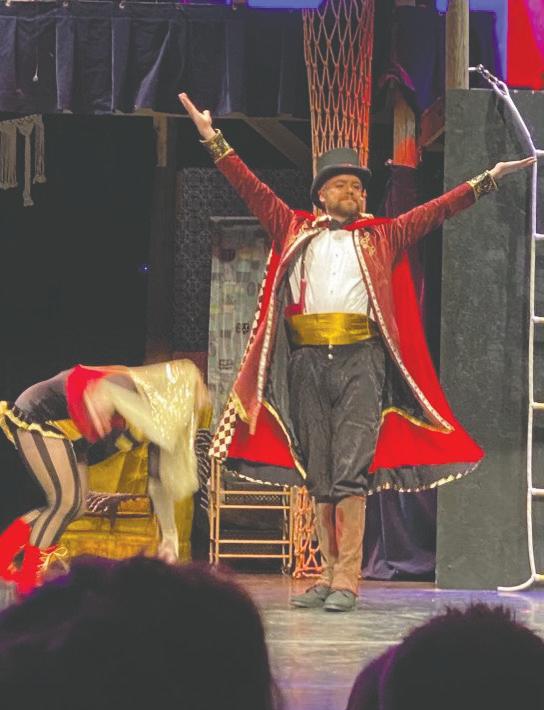
The students of Montana Tech know Research Associate Grant Wallace as a professional materials scientist focused on rare earth element recovery—but what many do not know is that Dr. Wallace also has an artistic side.
“I did a lot of musical theater and speech and debate in high school, before I came to Montana Tech to be an engineer,” Wallace said.
When Wallace was approached by Reanna Lange, a former Montana Tech employee who serves on the board of the Mother Lode Theater, about auditioning for the Orphan Girl Children’s Theatre’s fall production of Matilda , a musical, he was receptive to the idea.
Wallace was cast as Mrs. Honey’s father, an escapologist. As part of the show Wallace donned a fantastic costume, complete with a cape and a top hat.
“I had a lot of fun,” Wallace said. “They are a really good group.”
Wallace’s colleagues sang praises for the production.
“I really enjoyed seeing Matilda ,” Dr. Teagan Leitzke said. “I went with a group of people from Tech to support Grant in the musical. I knew Grant had done theater in the past, but I had never seen him perform before and it was fun to get to see another side of him. The musical was very well executed, with many talented actors, actresses, and musicians.”
Materials Science Ph.D. student Katie Schumacher watched the show with her family.
“My parents brought my niece and nephew over from Lolo to see Grant in the play for my niece’s 9th birthday,” Schumacher said. “I thought it was important for the kids to see that you don’t have to choose between STEM and the arts, you can do both. My niece thought the play was amazing, and loved seeing someone she knew onstage. She was shocked that Grant could not only play the banjo, but sing too! She did complain that he didn’t play the banjo during the show.”
The Orphan Girl Children’s Theatre is a community-based nonprofit that allows children ages 7–18 to put on several theatrical shows each year.
“The kids do most of the acting,” Wallace said. “They aren’t just in the show, though. They take sets down and put sets up. Pretty much everything backstage is being done by kids. They are fun, but they are all very serious about the production, too.”
Wallace rehearsed 2–3 nights per week during the fall semester. Another Montana Tech instructor spent even more time on the production. Fred Crase, choir director, is a longtime contributor to the organization. He’s been involved in most musical productions since 2016, and his wife, Elizabeth Crase, is the executive artistic director. Fred Crase’s role varies. Sometimes he teaches music, but other times he records and/or rearranges music to better fit the production.
Matilda was a major project for Crase. “Rather than using the provided music from the licensing company, they asked me to re-record the music and also be a live musical performer, so I spent a little over a month re-orchestrating and re-recording all of the instruments myself—I couldn’t resist adding some heavy metal flair to much of it—as well as learning some pieces to perform live,” Crase said.
Much of Crase’s work was done by sampling engine, played via keyboard. He recorded flute, clarinet, trumpet, trombone, saxophone, a complete jazz brass section, solo cello, full string section, and orchestral percussion this way.
Crase also actually played piano, organ, synthesizer, guitars, bass guitar, and drums for the basis of many of the tracks.
“Altogether, I think I recorded 14 or 15 sampled orchestral instruments and 6 in which I recorded my actual performances on the instruments,” Crase said. “I stayed more or less faithful to the original score, but again I did add some metal influence. Some of the music practically begged for it.”
The Orphan Girl Children’s Theater can always use volunteers. Apart from the more theatrical roles, there are opportunities to help design and build sets. Wallace thinks it’s the perfect fit for student groups needing some community service hours.
“I think there are some secret theater kids in the engineering department who would definitely get some enjoyment out of being involved,” Wallace said.
MNEWS SPRING 2024 39 38 MNEWS SPRING 2024
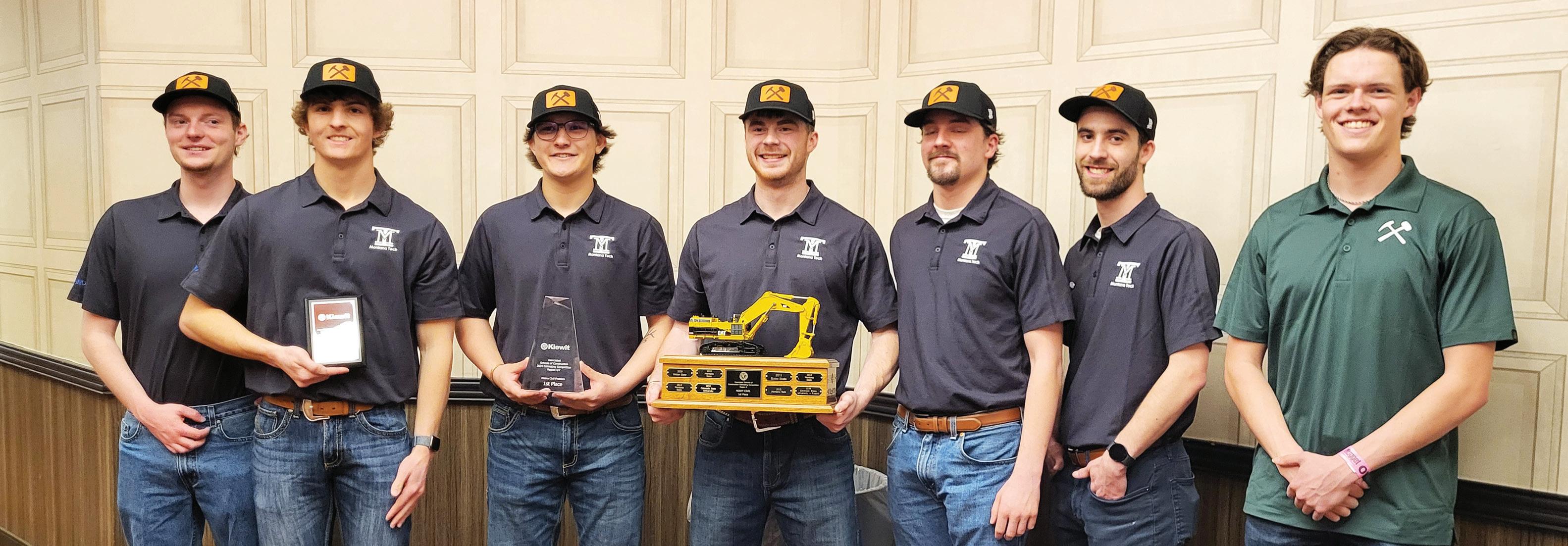
Heavy Civil Team Takes Home Top Honor
hree teams and three alternates from Montana Technological University competed in the 2024 Associated Schools of Construction (ASC) Region 6/7 annual construction bidding competition in Sparks, Nevada. Montana Tech entered a team in the categories Alternate, Commercial, Heavy Civil, and Project Management.
The University’s Heavy Civil team placed 1st in the Region 6 competition. The team was comprised of six seniors studying civil engineering who trained through the fall semester, focusing on learning various methods of constructing heavy civil projects. Though they had no prior competition experience, the Heavy Civil team members have a variety of construction experience through summer internships and work. The competition included 15 teams from universities in the Rocky Mountain region, including
Montana State, Colorado State, Northern University of Arizona, Brigham Young University (2nd place), and the University of Alaska (3rd place). The Montana Tech team included Jared Griffith, Gavin Dolechek, Bryce Hasquet, James Huckaby, Koby Martin, and Gabriel Roberts. Alternates were Will Wagner (competed in Alternates competition) and Sean Mehling (media liaison).
“Our team had a great understanding of individual roles, and how to work together,” Team Captain Jared Griffith said. “Our specific project, ‘The Hacienda Gulch Remediation,’ included several very challenging addendums throughout the competition that really put the pressure on our team to perform. The major deliverables of the project included: an executed contract, bid forms, project schedules, risk analysis, engineering plans (shoring and dewatering), and a 20-minute presentation with question and answer.” Griffith pinpointed one person as a valuable guide through the competition
“During training and competition, the team fully absorbs themselves in the project, just as they would if they were preparing a proposal for their future employer,” Sonya said. “They get the importance of giving it all.”
The second Montana Tech team competed in the Commercial category, which is sponsored by Mortenson. This competition included university teams from the Rocky Mountains, including Alaska though Idaho/Colorado to Arizona. This is the first time in many years that Montana Tech has competed in this category. The team wanted to change it up from their previous sponsor and category of Pre-construction to challenge themselves. They are very pleased with their efforts and new problem statement, and feel rewarded by this experience. Team members included Jade Morast (captain), Seif Benjemia, Andruw Brester, Chase Hinckley, Makenna Liles, and Cael Ricci. Alternate Holter Reisinger was on deck and ready to participate as needed. The team was coached by Bill Ryan of Dick Anderson Construction.
process. “With our entire team being completely new to the competition, an immense amount of credit goes to our coach Sonya Rosenthal for teaching us the details of the competition and preparation throughout the year,” Griffith said. “We are lucky to have such great coaches and advisors who care for the university and students.”
Adjunct Sonya Rosenthal has coached the Heavy Civil team for 10 years. In that decade, Montana Tech has placed in the top 3 eight times. Rosenthal expressed pride in how quickly the team learned and applied lessons from workshops and presentations from industry and coursework to solve their competition problems. At the competition, the team was given a Kiewit-sponsored problem of addressing a complex environmental cleanup project in a sensitive area in Southern California, with several contract amendments and last-minute tweaks in the bid proposal.
open category saw competition from 16 universities across the United States, including Texas A&M; University of California, Berkeley; Colorado State University; University of Colorado, Denver; Santa Clara University; Oregon State University; and California Polytechnic State University at San Luis Obispo. This is the third time in several years that Montana Tech competed in this category, and the team enjoys pushing themselves every year to learn new elements of project management. Team members included Thomas Walkup (captain), Parker Johnston, Kobe Moreno, Justus Peterson, Troy Springer, and Kyler Tesch. Alternate Mykhailo Tiutiunyk was on hand, and participated in the Alternates competition.
Civil Engineering graduate student
Andy Anderson works for the Montana Department of Transportation, and is the team’s industry coach. He praised the hard work and dedication the students showed in both preparation for and during the ASC competition.
Engineering, Construction Management, Petroleum Engineering, Welding, and Safety, and Health & Industrial Hygiene.
AGC club advisor Sonya Rosenthal wants to recognize the work that these students and coaches gave during their weekends and evenings to prepare for the competition. All three teams and alternates were very strong competitors, represented the school very well, and excited industry recruiters about our graduates.
“I am so proud of the work this team did to prepare and how well this team performed at the competition. This project was very complicated,” Ryan said. “The team worked on a project named The Beam on Farmer, which is a six-story office building for Mortenson’s Phoenix area office and a parking garage on a single city block in a busy area in downtown Tempe, AZ. The congested work area and heavy traffic created some logistical and scheduling issues the students had to assess and mitigate. In addition, the office building was constructed of cross-laminated timbers, which are manufactured and shipped from Austria, adding to the work schedule complications.”
“The students volunteered hundreds of hours of their personal time to further their knowledge of the construction industry, and competed against schools 14 times larger than Montana Tech,” Anderson said. “I’m proud of the work they put in, and excited to earn our spot on the podium next year.”
Three of the four alternates were able to travel to Nevada and compete in the Alternates Competition. The Alternates Sponsor, Rudolph and Sletten, formed teams of eight students from across the 54 construction schools that were in attendance. Their problem statement was related to a complex California zoo expansion. The three freshmen alternates enjoyed the challenge of working with their respective new teams and delivering a proposal in such a short time frame. Two of the Montana Tech alternates represented their teams in the interview process.
“Each student committed their time and energy to perform well, and to have fun in the process,” Sonya said. “This experience gives each of them an extra edge in their career.”
Associate Professor and Mining Engineering Department Head Dr. Scott Rosenthal took the opportunity to attend the competition, as he judges the mock trials put on by the coaches.
“The Montana Tech students were prepared, confident, and professional throughout the competition,” Scott said. “They were a positive reflection on themselves, their coaches, and Montana Tech. It was so moving to be there when Montana Tech, the smallest university competing, pulled out 1st place in Heavy Civil.”
The Lance College of Mines and Engineering Dean Kenneth Lee agreed.
“It was so exciting to see the students compete and kudos to all participating students,” Lee said. “The industry recruiters were all over them. These students will have great career options.”
Ryan added, “The Montana Tech community should be very proud of all three teams who competed; I know we coaches are.”
The third Montana Tech team competed in the Project Management category sponsored by DPR Construction. This
The AGC Club at Montana Tech is open to all students in any major interested in learning about the construction industry. The teams include a mix of students in two-year and four-year programs from Montana Tech’s north and south campus, a unique strategy that has strengthened the teams.

Overall, the competition categories that the club selects match the many courses available at Montana Tech with our students’ future careers. The 2023/2024 team members are studying Civil
MNEWS SPRING 2024 41 40 MNEWS SPRING 2024
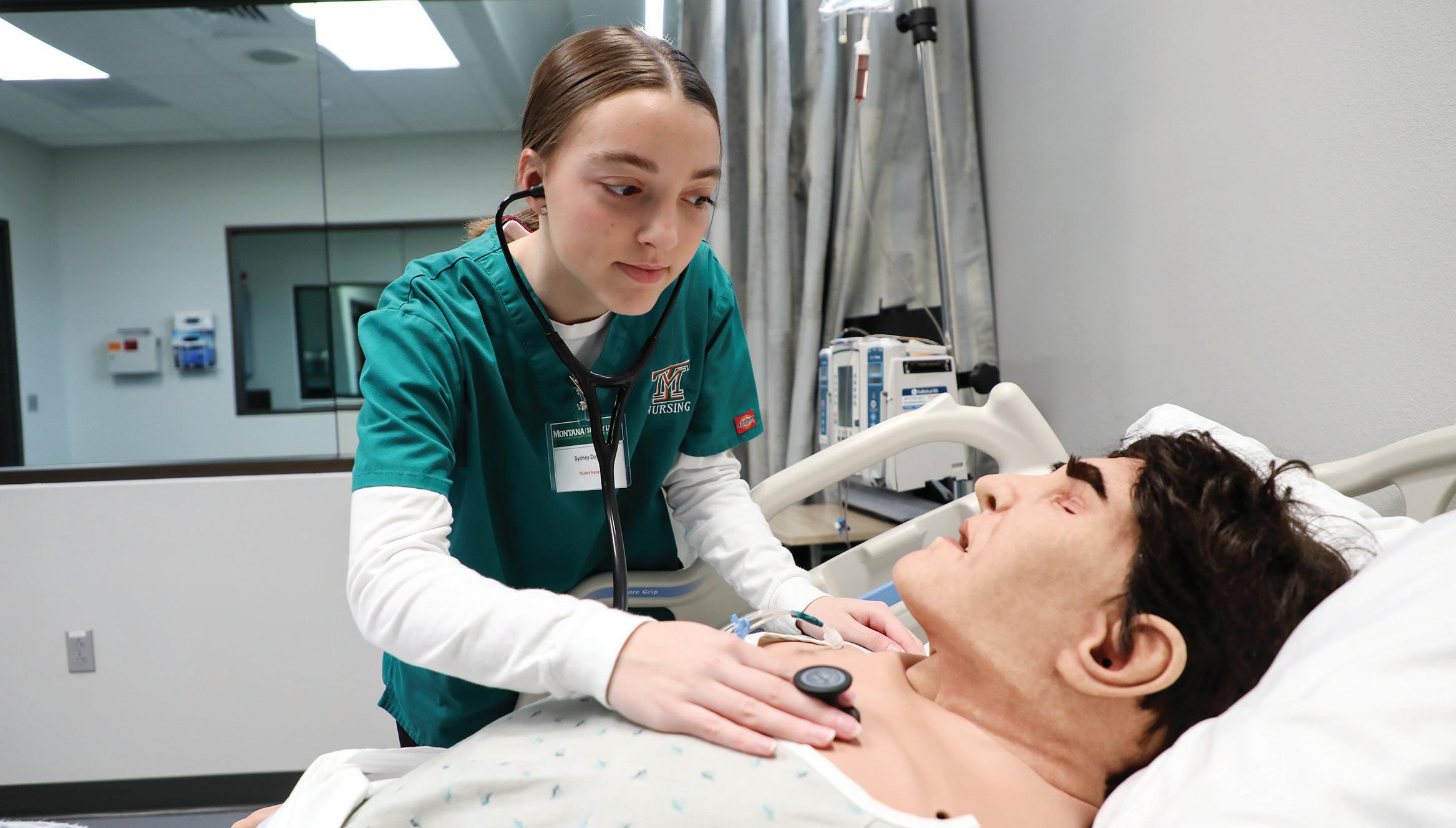
Liberty Energy Scholarship Transforms Lives
By Megan Strickland
ydney Doyle and Myles McClernan say they only ever had one college in mind as they filled out applications in their senior year at Butte High.
“I never really had intentions of leaving Butte,” Doyle remembers. “It’s just been home, and hopefully it will be forever, so when it came time to apply for school, it felt natural to apply to Montana Tech.”
However, when Doyle filled out her federal student aid application, she was hit with some difficult news. She did not qualify for any type of federal aid besides student loans.
“The only option I had was to take out a loan,” Doyle said. “I was dead set on not doing that.”
Doyle applied for scholarships and hoped they would cover the cost of her education. One day in spring 2020, she, McClernan, and 15 other Butte High students were called to the office at the end of their senior year. School officials informed them they would be the first recipients of the Liberty Energy Scholarships.
The Liberty Energy scholarships were established in 2019 with a $400,000 gift that will be expended over a 10-year period. The scholarship covers the unmet financial need of Butte students after other scholarships and grants are applied.

“Liberty’s mission is to better human lives, and there is no better example of them doing this than through the Liberty Scholars Program at Montana Tech,” Montana Tech Chancellor Les Cook said. “The program is providing opportunities for students who would have never considered education as an option. We couldn’t be more grateful for Liberty’s support and the difference they are making in the lives of our students.”
“We are extremely appreciative of our partnership with Liberty Energy,” said Luke Meyer, Vice President of Development for the Montana Tech Foundation. “Liberty is literally changing students’ lives through the Liberty Scholars Program and directly energizes and advances the industries and communities in which our graduates work and live.”
Doyle and McClernan are on track to graduate this year without any student debt. Both are headed into fields where the energy produced by Liberty plays a vital role in creating the equipment, infrastructure, and electricity required to do business. Doyle is a Nursing student who wants to serve the community she grew up in.
“Nursing is a profession where you can go anywhere, and have so many different career options within the field,” Doyle said. “It gives me some peace of mind knowing that I have options. I hope to end up in obstetrics or a family practice setting, so I’m around families within my community, interacting with them as they grow.”
McClernan is studying Electrical Engineering. He interned for Nucor
FIRST CLASS OF LIBERTY SCHOLARS
Steel in Tennessee in the summer of 2022 and interned again with the company in Plymouth, Utah in Summer 2023.
“It would be great to end up working for an energy or power company in Butte,” McClernan said.
The Liberty Scholarship played a pivotal part in both students’ futures.
“Thank you for this amazing opportunity, for helping pay for our futures through our education, for opening doors for us, and for believing in the Butte community and our ability to succeed through Montana Tech,” McClernan and Doyle said.
Jenna Hodges Ty Insko
MNEWS SPRING 2024 43 42 MNEWS SPRING 2024
Ravyn Goodwin
Myles McClernan Haylee Powers Isabelle Ralph-Puderbaugh
Electric Vehicle Market Offers Opportunities for Students in STEM
By Megan Strickland
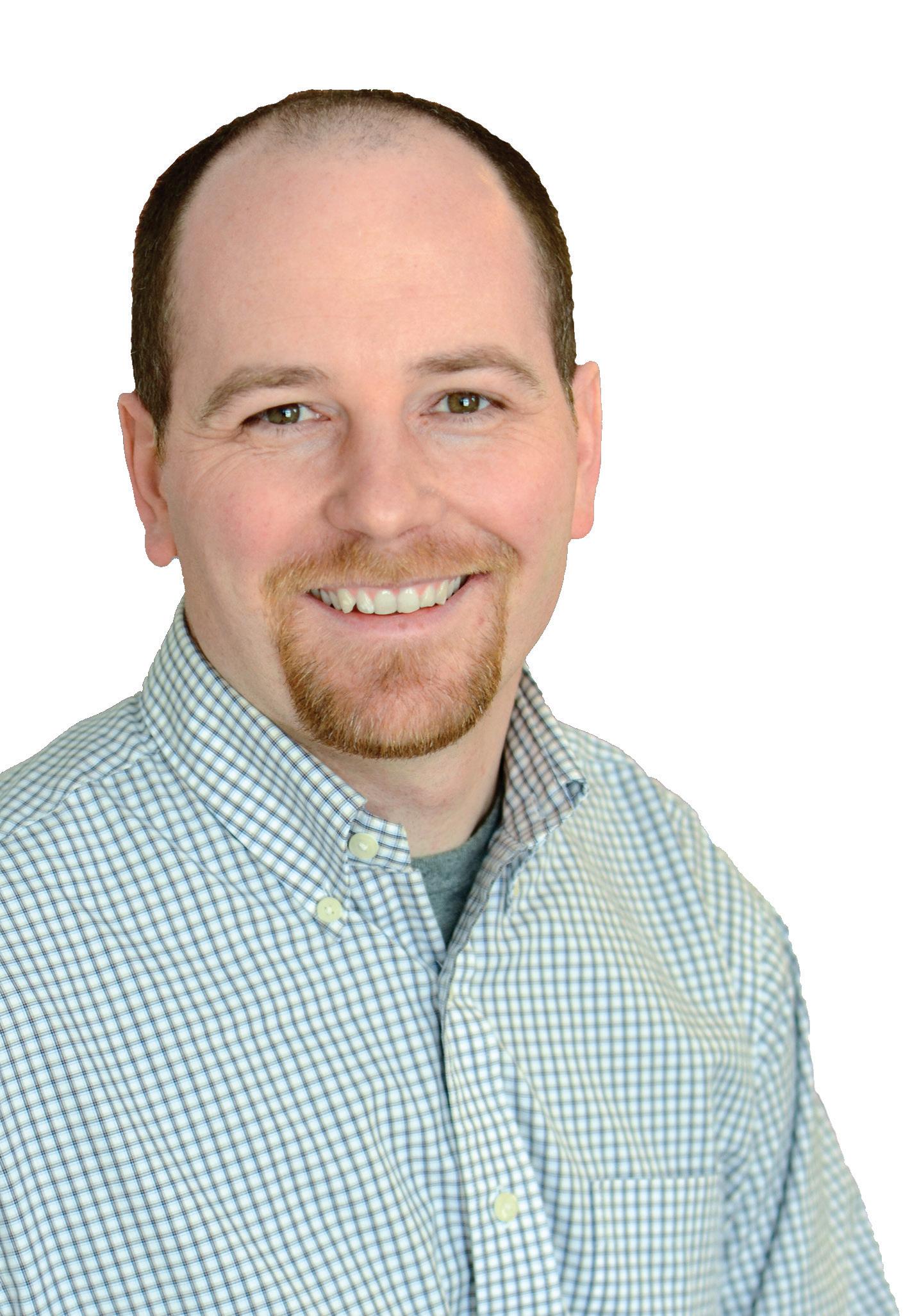
ean Everett (BS Environmental Engineering, ’04) graduated from high school in Libby, Montana, just as cleanup began at the site of one of America’s worst humancaused environmental disasters. Two decades later, Everett has taken his Montana Tech education and is impacting the world around us via his position as Electric Vehicles Power Lead at HDR in Missoula.
“Today, I work with HDR’s Zero Emission Mobility (ZEM) group and plan and design EV charging systems, primarily for fleets, though I’ve also worked on highway traffic corridor studies and NEVI programs for light-, medium-, and heavy-duty vehicle charging. NEVI is the National Electric Vehicle Infrastructure formula program under the 2021 bipartisan infrastructure bill,” Everett said.
Electric vehicles were not on Everett’s radar as a possible career field when he was at Montana Tech. At the time, hybrid vehicles had only just started to appear on the market.
“EVs and renewable energy projects were not the type of remedial environmental engineering I had anticipated when I was at Tech or in the years immediately afterward,” Everett said. “My path swayed with career opportunities in water/wastewater engineering when I joined HDR in 2007, then again into power delivery during the Bakken oil boom, and about four years ago into EV charging.” The EV industry offers numerous opportunities as it expands
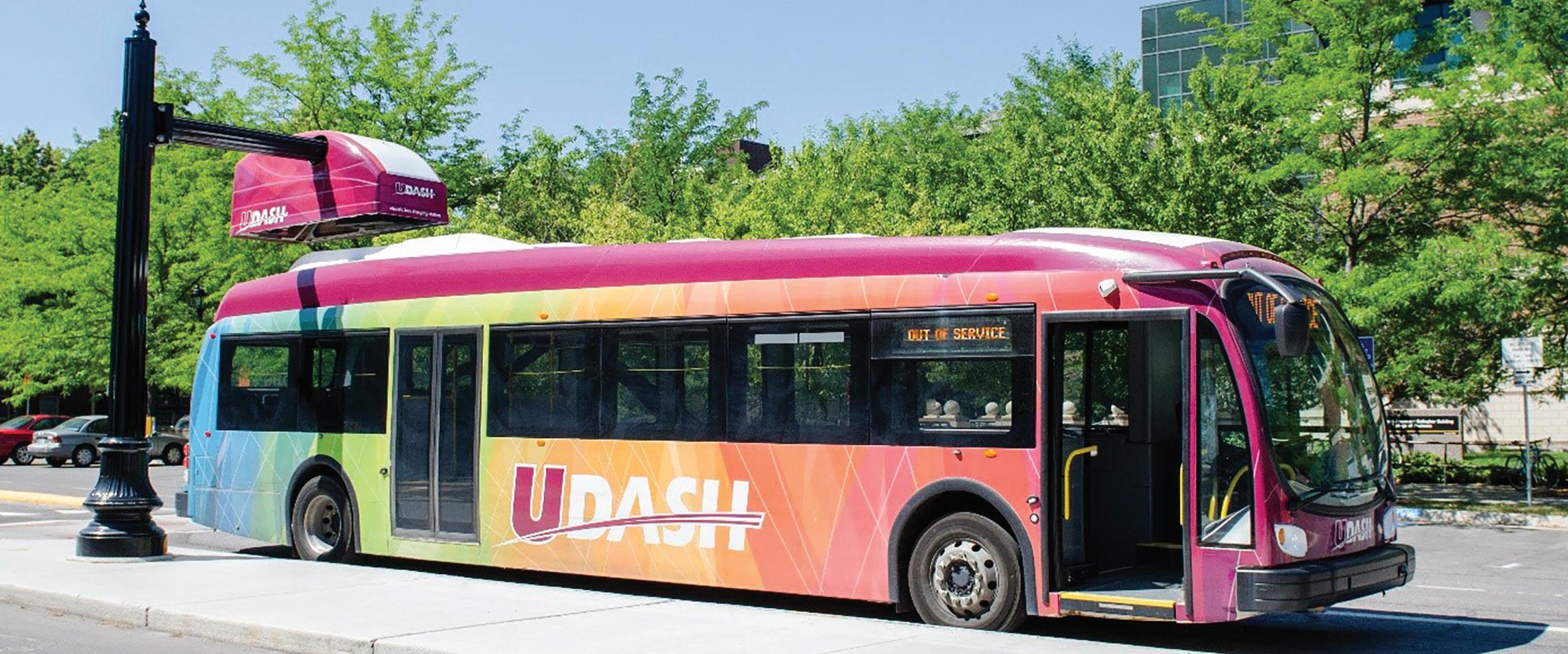
quickly. “The fields of electric vehicles, zero-emission mobility, and renewable energy are changing rapidly,” Everett said. “There is a great need for good engineers to provide solutions for developing problems, and there will be exciting challenges that we don’t even know about yet. One big concern is getting all the power needed, and associated costs, for the electrification and conversion from hydrocarbons.
We need to find a balance between the existing tried and true and the shiny new toy. Engineers are great ambassadors for pushing the envelope while also speaking rationally about what is possible or what may be very expensive.”
Everett said his Montana Tech education helps him bring a problemsolving mindset to his projects.
“One of my favorite Tech professors, Dr. Rod James, told us two important things that have stuck with me throughout my career, and I’ve tried to pass them on to younger engineers,” Everett said. “The first is that the two most important classes for engineers at Tech were Technical Writing and Engineering Economics. You have to be able to convey to others how to do or understand
what you want them to know, and then you have to tell them how much it will cost.”
“The second thing that Dr. James said was that professors at Tech didn’t want to teach how to find an answer for a test, but to be able to think and solve actual problems. When students know how to analyze the root of an issue, they will be able to solve nearly any problem.”
“Dr. James’ words have held true to me, as effective writing and problemsolving have allowed me to navigate different engineering disciplines throughout my career,” Everett said.
Everett had advice for students considering a career in STEM.
“Engineers should continue to have job security in the future,” Everett said. “As we are in the field for a while, we think less of the majors and more of the job function. The electrification and zero-emission space use many disciplines. Definitely electrical, but also civil, mechanical, communication, and structural engineers are needed for charger deployment and improvements to the electrical grid. Chemists are also central players in the development of
better battery technology. Good planners provide a first step of what’s feasible and recommend advancing the field without breaking the bank. Permitters are needed for rapid deployment. Cost estimators provide detailed assessments to make critical decisions. And finally, laborers shouldn’t be discounted, because backlogs on equipment manufacturing and installation delay project construction by several years.”
While people might think of more urban areas as EV technology hubs, Everett says Big Sky Country has plenty of opportunity.
“HDR has a strong connection to Tech grads, often in the mechanical, civil, structural, and electrical engineering disciplines,” Everett said. “As a 12,000-person, global, employee-owned firm, we work on projects well beyond zero emission, renewables, and electrification, so most disciplines offered at Montana Tech are employed at HDR. Our six Montana offices of over 250 staff work on a variety of projects from electric transmission/distribution and substations to water and wastewater treatment to highways, railroads, and more. It is really a great time to be an engineer, and Tech produces some great ones.”
MNEWS SPRING 2024 45 44 MNEWS SPRING 2024

MONTANA TECH TEAMS TAKE TOP HONORS AT 46 TH INTERNATIONAL COLLEGIATE MINING COMPETITION
Montana Technological University teams won top honors at the 46th International Collegiate Mining Competition held in Butte, Montana.
Three dozen teams from the U.S., Australia, the United Kingdom, and Canada competed. Montana Tech’s Men’s Team “The Original,” took first place and the Sunshine Trophy, by placing first in jackleg drilling, hand steel, and survey. They placed second in track stand and swede saw. Montana Tech’s Men’s Team “Badgers” took third place overall, placing second in mucking and survey, and third in gold panning and hand steel.
The Women’s Team, “Orphan Girl,” consisting entirely of first-time freshman competitors, took fifth overall.
Montana Tech had two alumni teams compete. One took home first place overall in the alumni division, after taking first in mucking, swede saw, jackleg drilling, track stand, and hand steel, plus third place in gold panning and survey. The second team took third place overall, after taking first in survey, second in gold panning, and third in mucking, jackleg drilling, track stand, and hand steel.
The International Collegiate Mining Competition is held in a different location every year. The last time the games were held at Montana Tech was 2016. Next year’s competition will be held at the Camborne School of Mines in the United Kingdom.
In Memory
We extend sympathy to the families of the following alumni who have passed away over the past few months.
1950s
John Alan Alexander
BS Metallurgical Engineering
G. Ben Huber
BS Mining Engineering
1960s
Donald James McMillan
BS Metallurgical Engineering
Charles Parrett
Don R. Rolfe
Frank A. Wills
1980s
Daniel Kipp
Frank B. “Sparky” McGarry
AA Associate of Arts
1990s
Ronald Lee Krusemark
BS Mining Engineering
Daniel K.McLeod
BS Business & Information Technology
Earl M. “Mel” Rauch ‘90 BS Business Administration
2010s

‘52
‘56
‘61
‘67 BS Engineering Science
‘62 BS Mining Engineering
‘66 BS Geophysical Engineering
‘15 BS General Engineering/Civil Engineering Option
‘15 BS Petroleum Engineering
Ryan Kirkwood Pearson
Mark A. Robillard
‘85
BS Petroleum Engineering
‘87
‘95
‘99
Members of the Montana Tech International Mining Competition teams Photo courtesy of Jess Scanlan
MNEWS SPRING 2024 47 46 MNEWS SPRING 2024
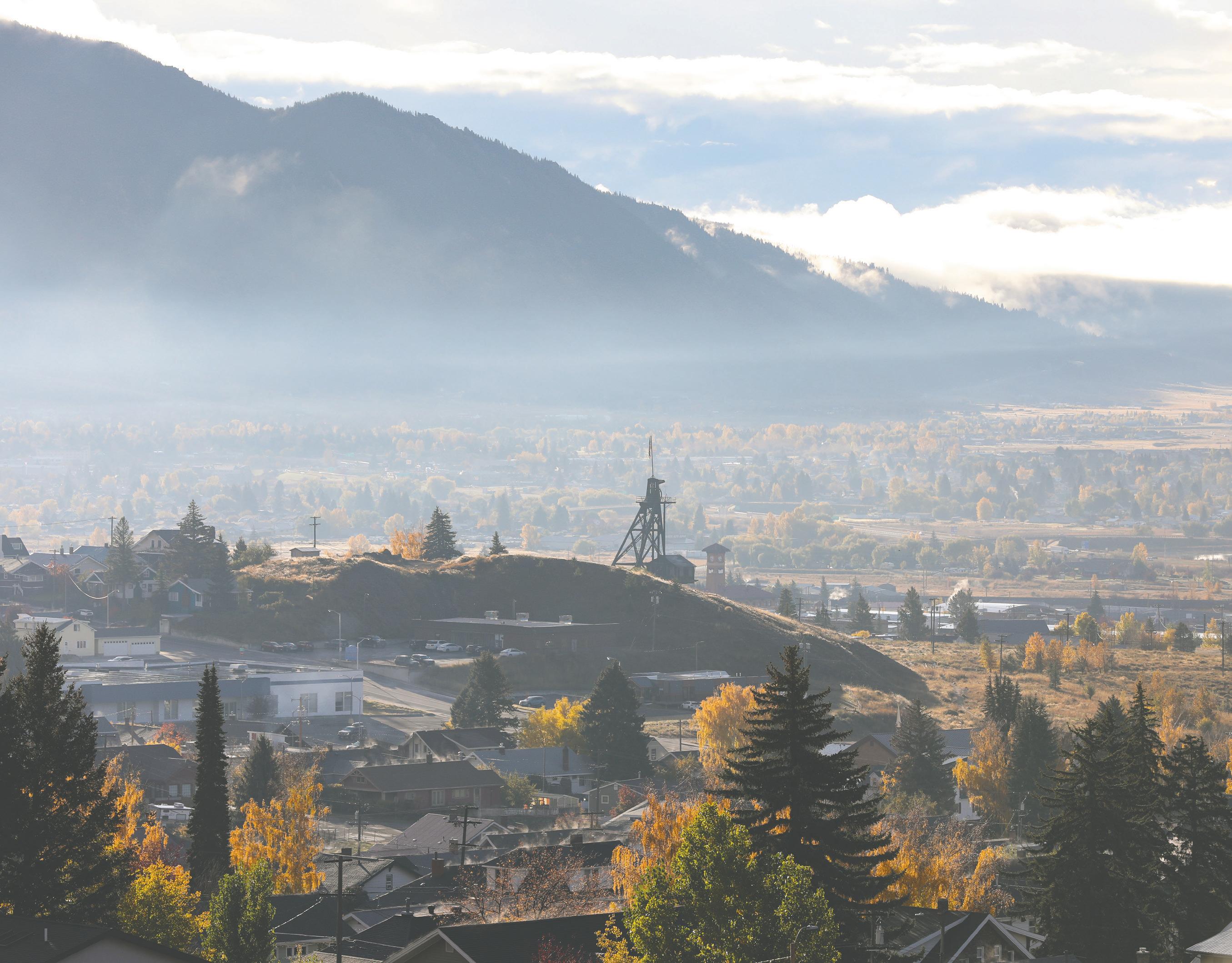
Non-Profit U.S. Postage PAID Great Falls, MT Permit No. 151 1300 West Park Street,
59701-8997 Return Service Requested
Butte, Montana

































 By Megan Strickland
By Megan Strickland























 Bob Hark
Bob Hark


















